Dr. Sultana Nurun Nahar
RESEARCH:
Atomic Astrophysics, Spectroscopy, and Astrophysical and Biomedical
Applications. Our research involves both theoretical and computational
developments. Facilities at the Ohio Supercomputer Center (OSC) of OH-TECH
have an integral part of projects.
The Opacity Project (OP) and The Iron
Project (IP) collaboration, and
the OP
Objectives, and
the IP Objectives
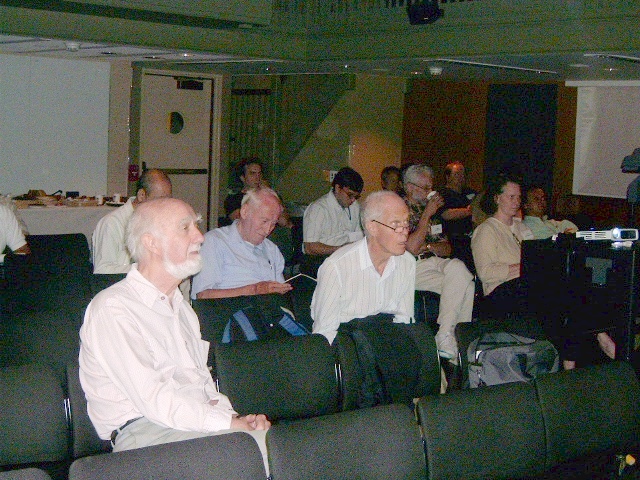
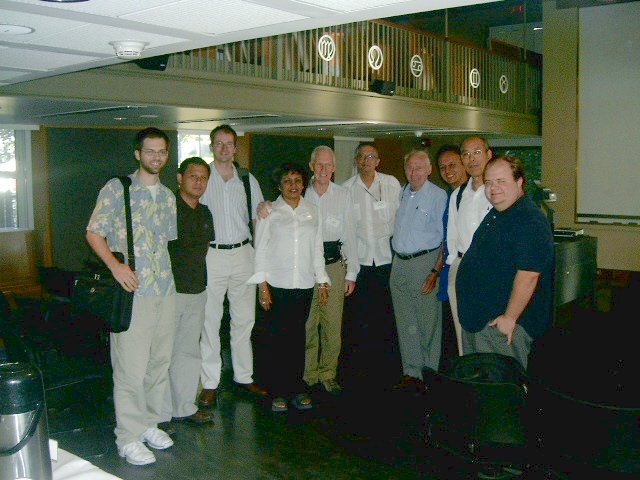
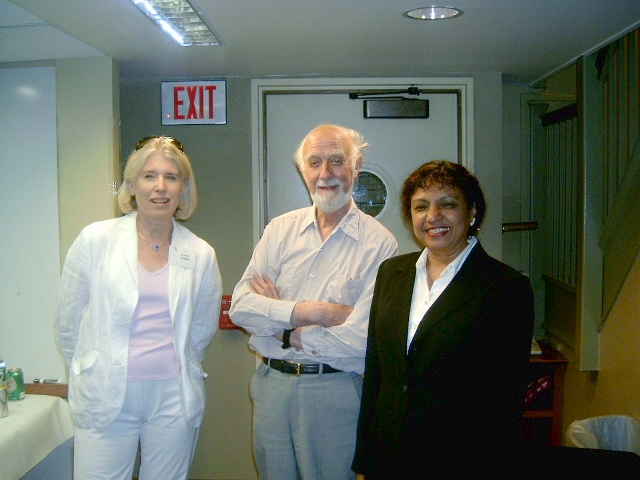
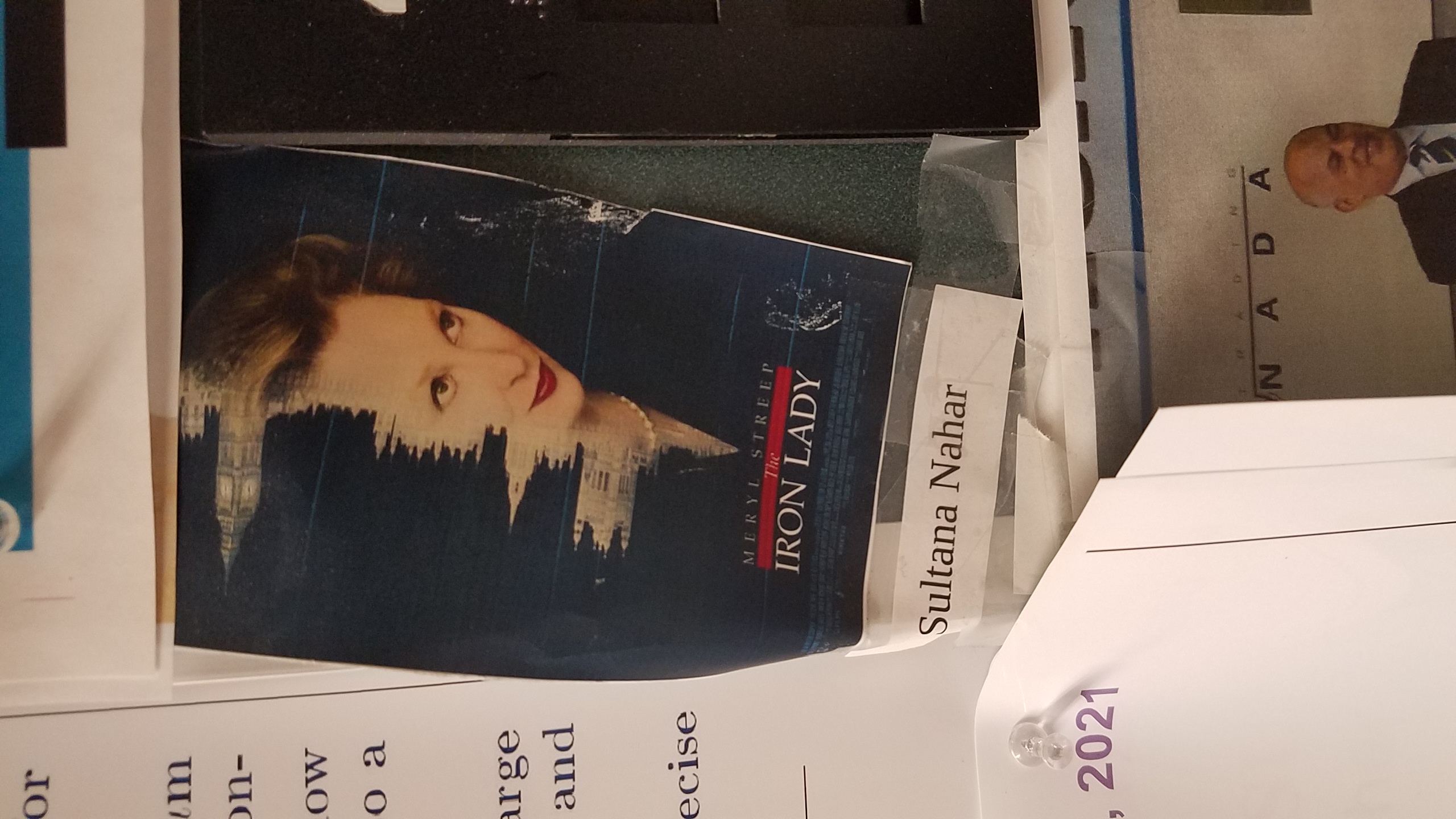
Pics: 1-3: Harvard University (Cambridge, Massachusetts) workshop, August 7-8, 2006:
Iron Project members and "High
Accuracy Atomic Physics in Astronomy", Honoring M.J. Seaton, workshop
organized by A.K. Pradhan and S.N. Nahar,
Pic 4: Astronomy students labeling Nahar "IRON LADY" on her office door
- ITAMP (Harvard-CfA) newsletter, "High Accuracy
Atomic Physics in Astronomy", Spring 2007
As a member of the international collaborations,
the Opacity
Project and
the Iron
Project , a significant part my research is related to them.
Objectives of the projects: To study and calculate accurate atomic
parameters for radiative and collisional processes of astrophysically
abundant atoms and ions for applications to astrophysical plasma.
Theoretical calculations employ state-of-the-art quantum mechanical
techniques based on the ab initio R-matrix method in the close coupling
approximation.
Leading contributor for the radiative processes of the Iron Project team
The atomic processes under investigation are dominant in astrophysical
plasma. The results are applicable to both astrophysical and laboratory
plasma for spectral and diagnostic analysis.
PUBLICATIONS (Nahar full list):
Publications on solar opacity
OP Publications: They are in the two compiled volumes - The Opacity
Project Team ."The Opacity Project", Vol 1, 1995, Vol. 2, 1996, Institute
of Physics Publishing
IP Publications: Partial list at
"The
IRON Project Publication List"
Additional IP/OP publications at webpage of member
Prof. Anil K. Pradhan
Examples of invited presentations:
- Zewail City of Science and Technology, Egypt, March 7, 2013:
"Solar plasma opacity and nebular elemental abundances", Sultana N.
Nahar
- Intl Symp on Climate Change & Food Security in South Asia 2008 (UN
sponsored), SESSION 4: "Solar Irradiation of the Earth's Atmosphere"
MEETINGS:
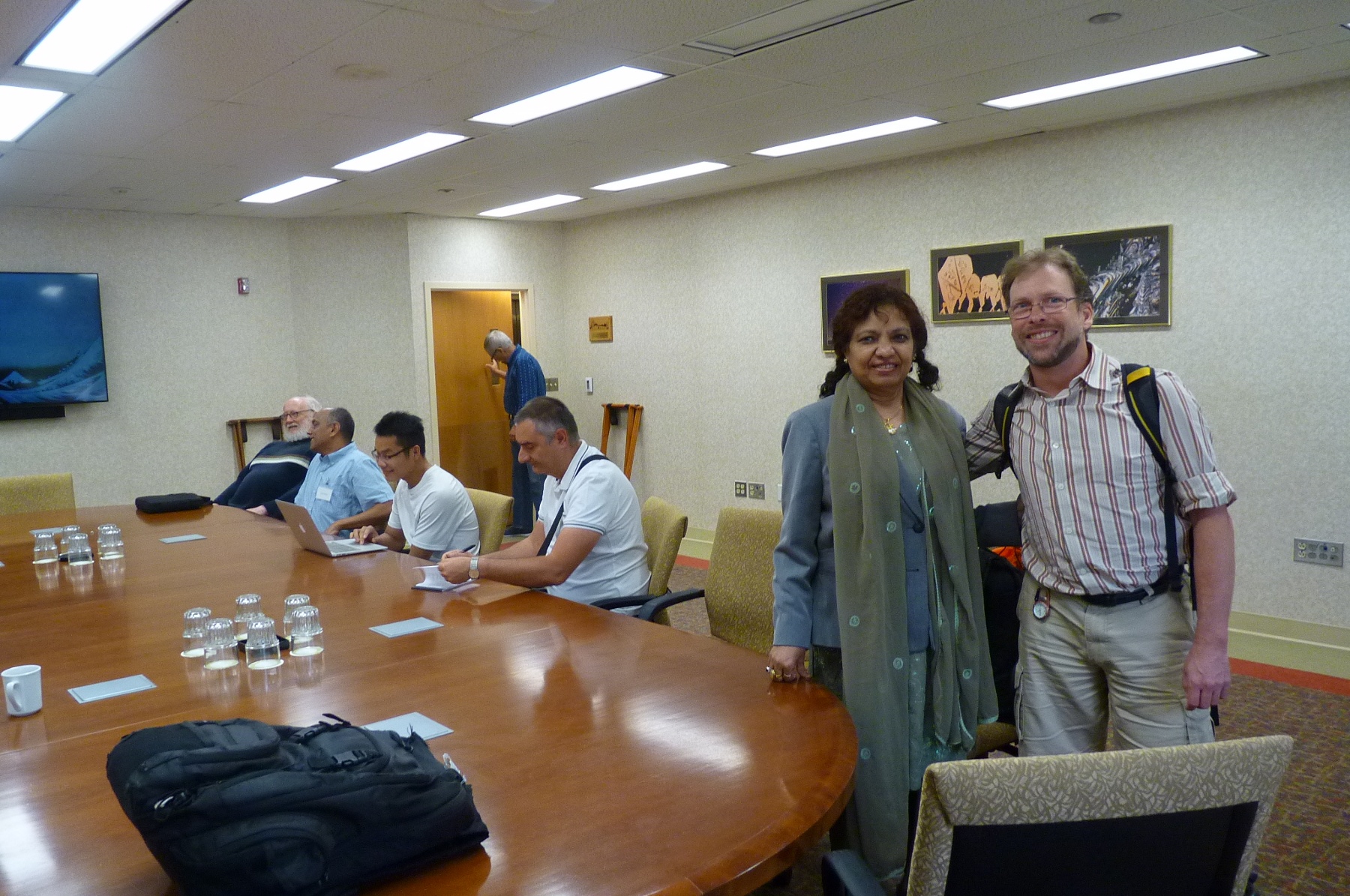
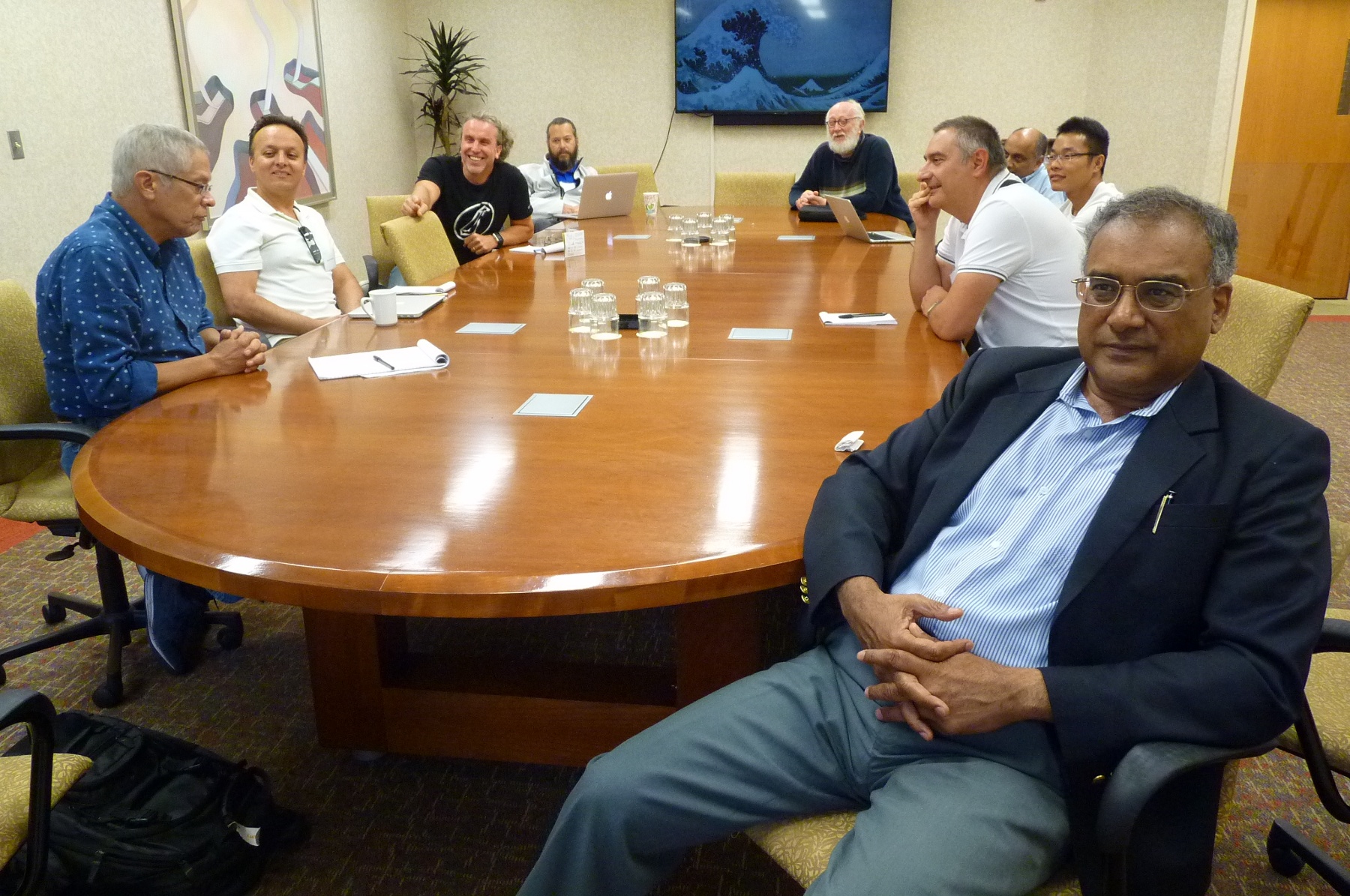
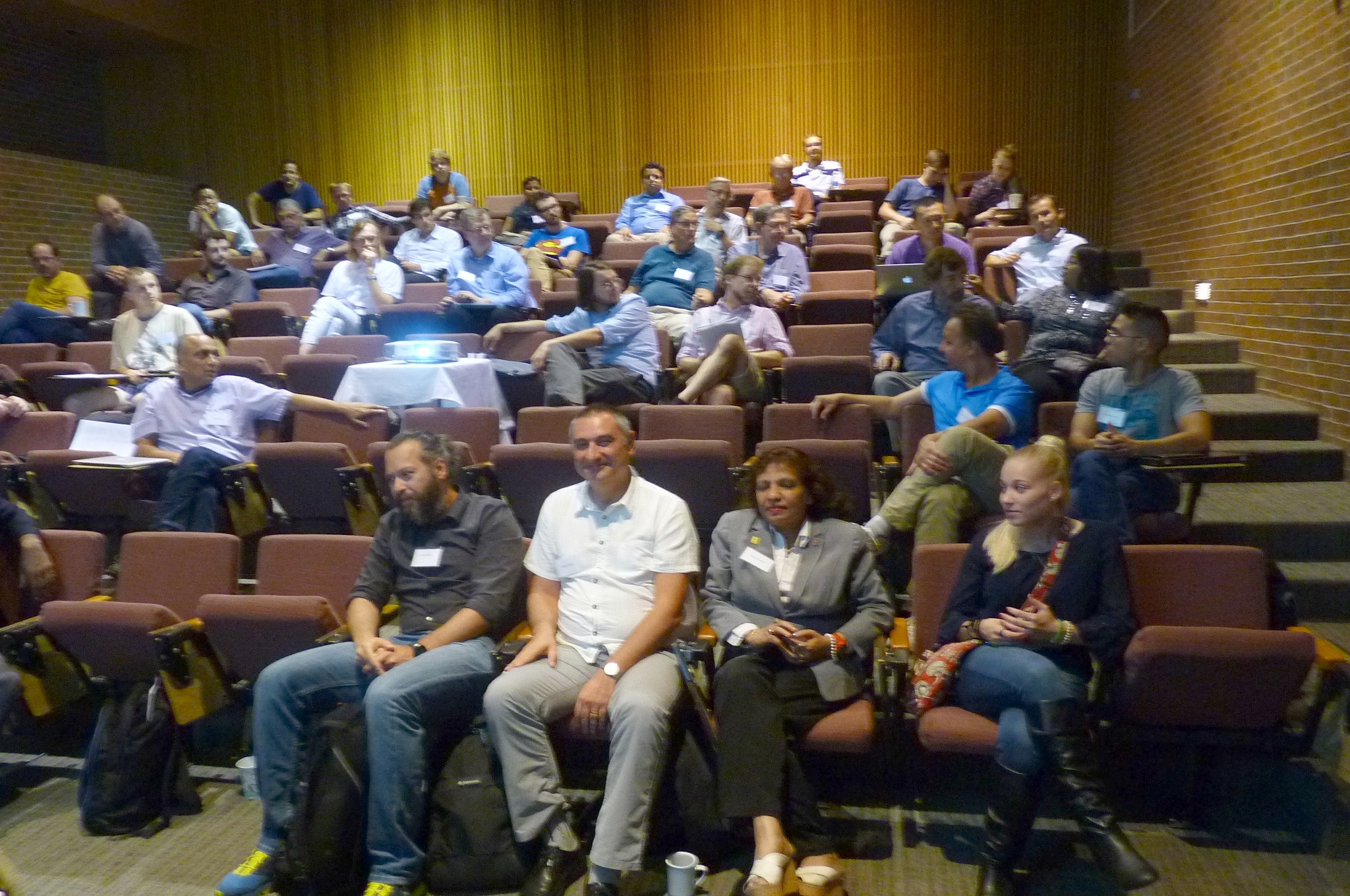
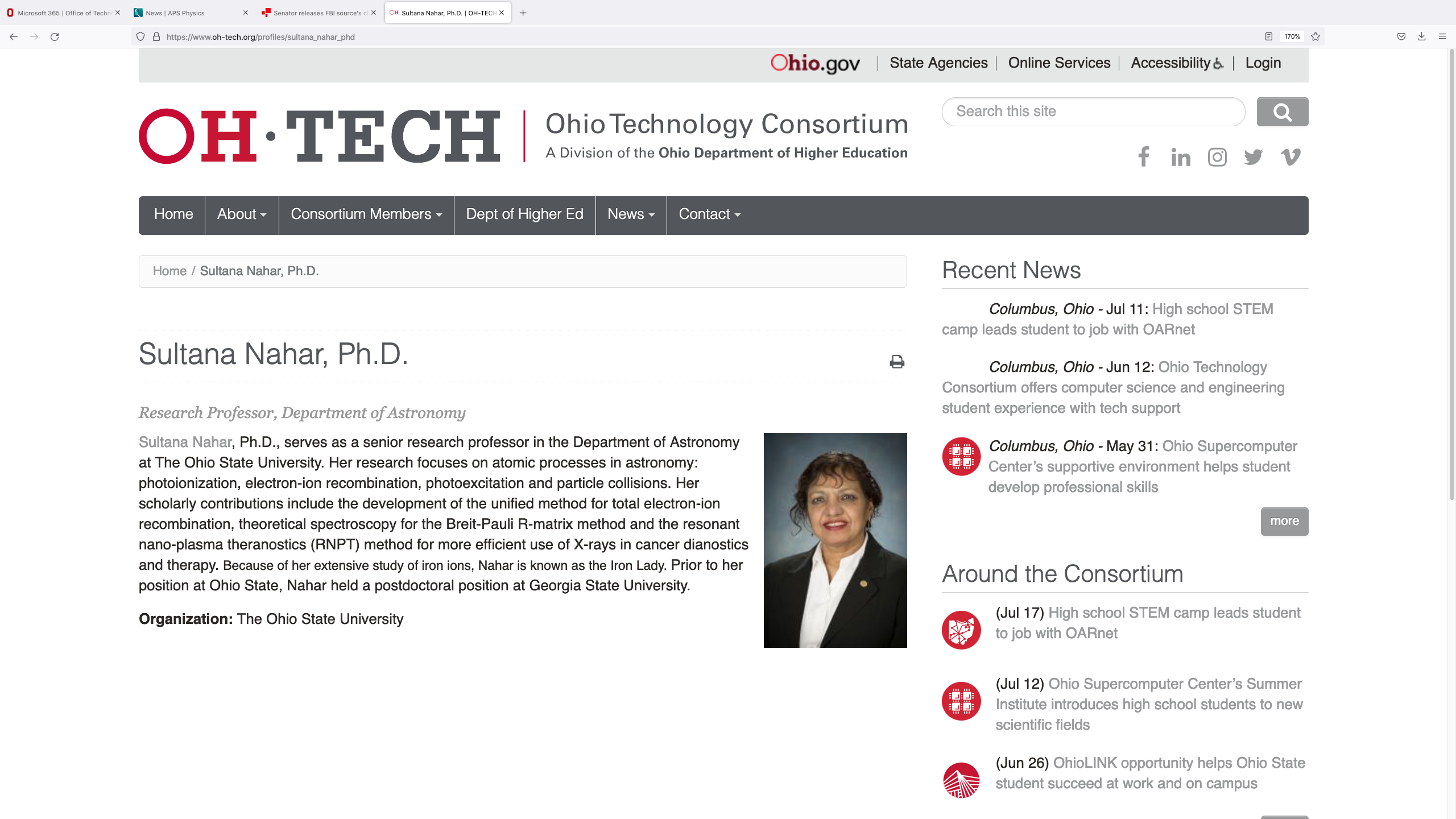
August 2017: Iron Project and OP/IPv2 meeting, i) Regener, Sultana,
Patrick, Claudio, Shashi, Lianshui, Tony, ii) Anil, Patrick, Lianshui, Shashi,
Tony, Javier, Franck, Manuel, Claudio, iii) Discussions - Workshop on
Astrophysical Opacities (WAO), Western Michigan University, Kalamazoo
TEAM MEMBERS (past and present) are from a number of places:
- The Ohio State University,
- University College London,
- Stuttgart University,
- Observatorie de Paris
- Belfast University,
- IVIC-Venezuela,
- Sheffield University
Dr. Lotfia El Nadi, Egypt, and others
:Iron Lady" for considerable work on iron ions referred in:
- In the first annual OSU Astronomy Magazine:
"Meet the Iron Lady", p.21, 2005
- Chapter 5: "Dreaming of the
Star Treatment" in the book "Science Unshackled" (Renee James, Fall 2014,
Johns Hopkins U press)) describes astronomical study and leads to cancer
treatment that we propose, Title of section 35 "The Iron Lady and the
Gold Standard"
- In "What has astronomy done
for you lately?" in
Astronomy magazine, May 2012, p.31-35
(4 items: GPS, wireless internet, RNPT, and laser surgery of eyes)
- OSC Highlights "High-precision atomic
astrophysics: From black holes to nanotechnology" of its calendar, Feb, 2010
- Ohio Supercomputer Center (OSC) press release
"X-ray
researchers turn focus from black holes to cancer", Columbus, OH,
January 28, 2010
SOLAR IRON OPACITY:
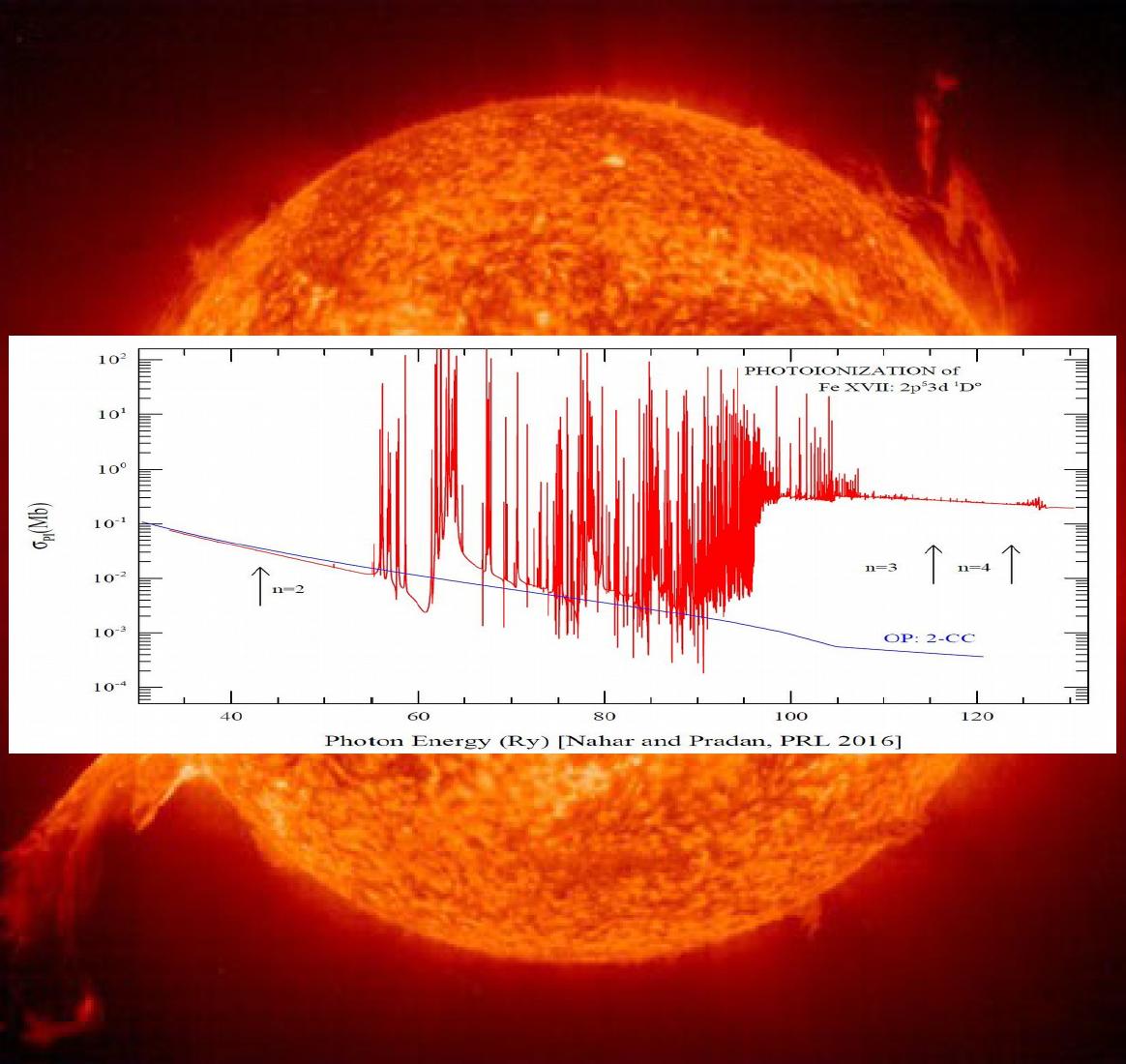
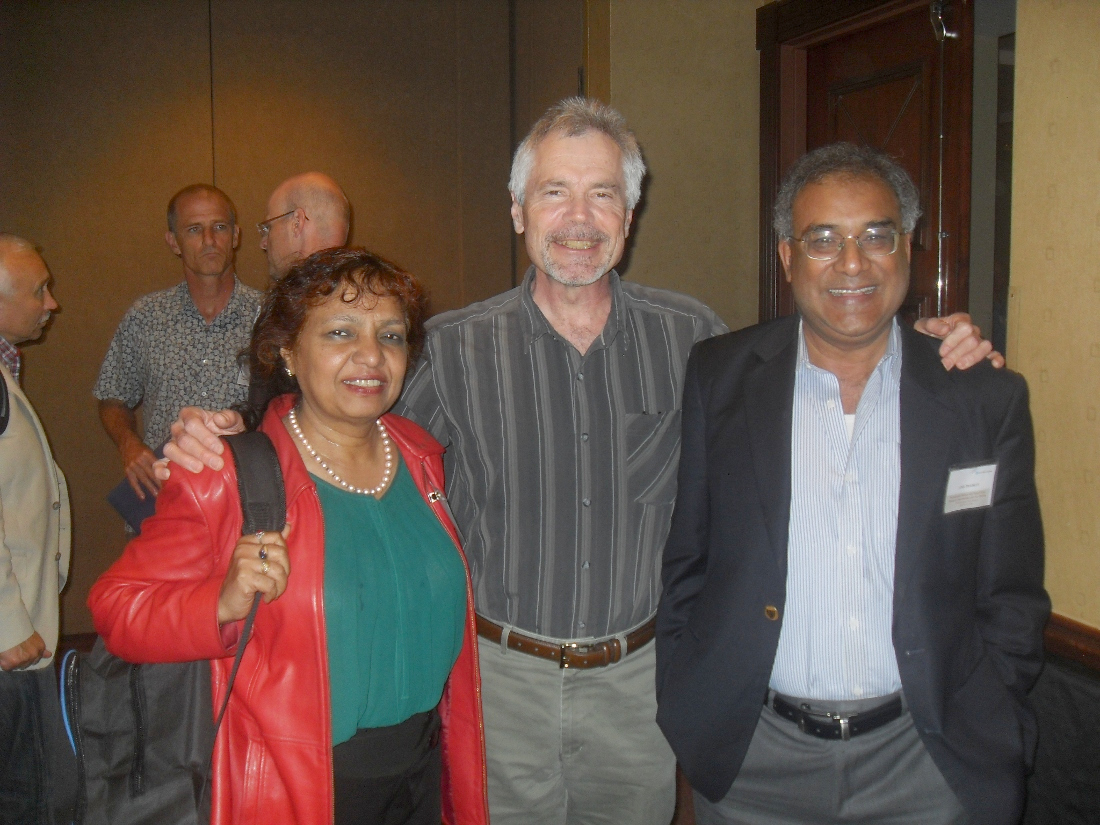
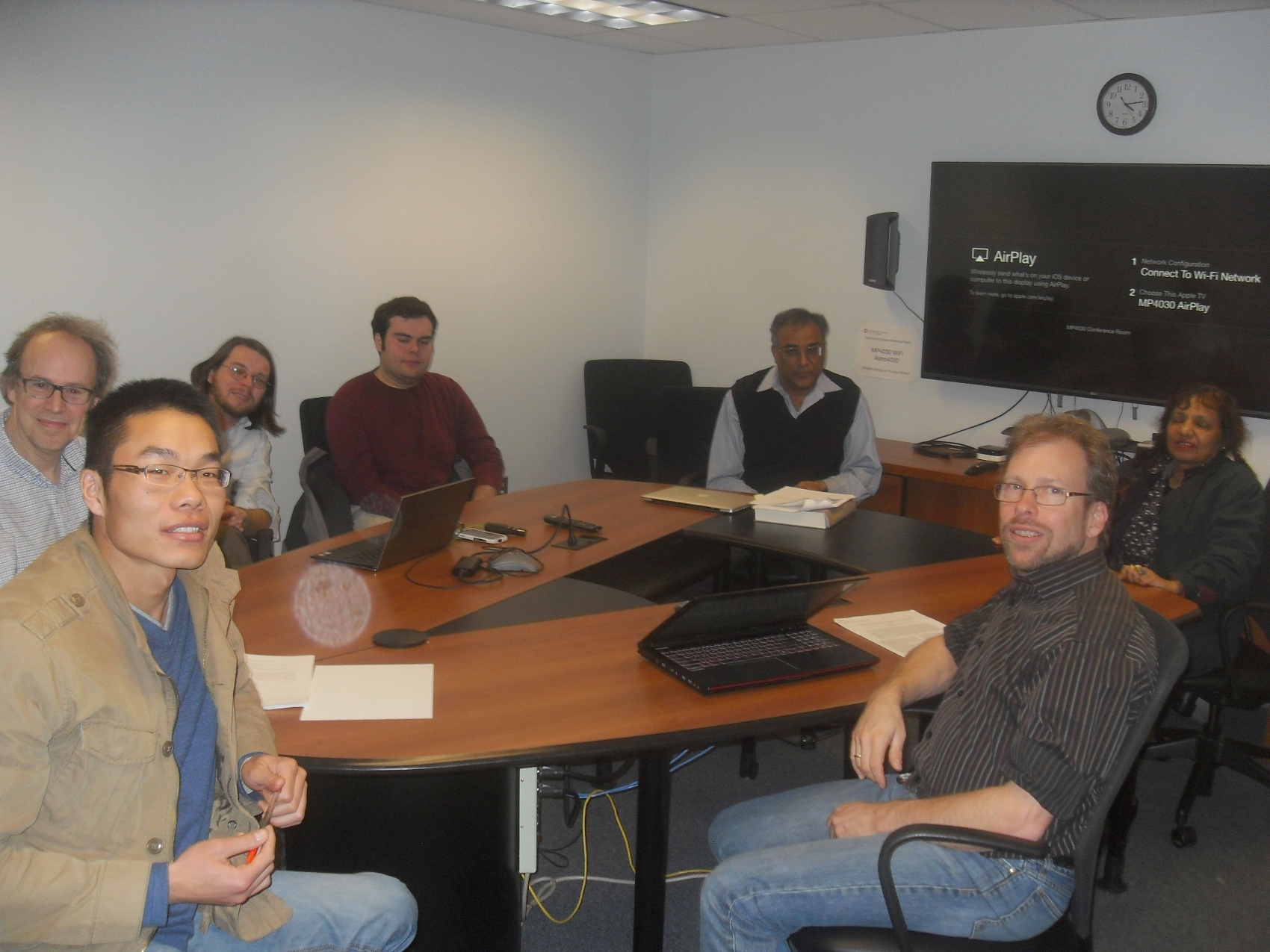
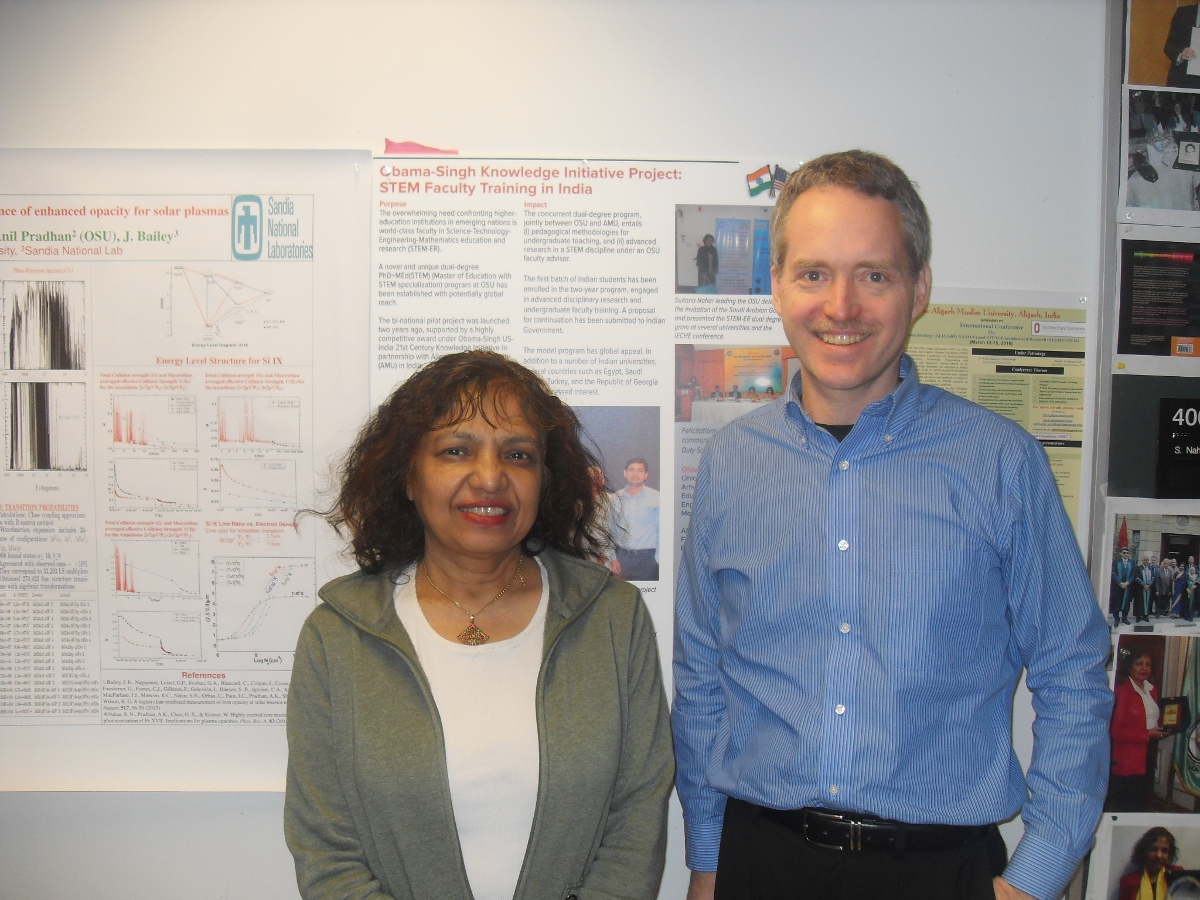
Project collaborators: L: Sultana, Jim Bailey, Anil at Sandia Z Workshop
2015, M: Group meeting at OSU with Reger Trampedach from Space Sciences
at Colarado 2017, R: OSU visit by
Jeff Valenti for UV opacity project, 2016
Objective: Solar opacity is directly related to its abundances of
elements and iron
is one dominant element causing considerable opacity. The solar iron opacity
project aims to resolve the decade long standing controversy for the
abundances of the sun.
Description of the process: High
Accuracy Radiative Data For Plasma Opacities, Invited presentation at
ASOS 2010, Berkeley
PUBLICATIONS:
On oscillator strengths
and photoionization of Iron ions (Fe XIV - Fe XX) for solar opacity
Recent extended work on Fe VIII photoionization using 99-cc
wavefunction expansion by Nahar indicates considerable missing photoabsorption in
the current opacity, Z Fundamental Science Program Workshop, Sandia National
Lab, Albuquerque, July 2015
OSC press release featuring story titled "Ohio
State astronomy researcher unveils the sun¿s secrets with OSC support" on
the web, October 17, 2024 (to be included in the OSC Annual Report for
distribution.)
Team members of IRON OPACITY Project:
Professor Anil K.
Pradhan, OSU, USA
Dr. Werner Eissner, Stuttgart
University, Germany
Dr. Chris Orban, OSU
Dr. James E. Bailey, Z Fundamental Science Research (ZFSP), Sandia
National Lab, Albuquerque, NM, at
ZFSP workshop 2015, Albuquerque
Dr. Regner Trampedach, Space Research Lab, Colorado at
ZFSP workshop 2015,
Albuquerque
OPACITY OF COOL STARS:
Objective: Study opacity of neutrals or near neutrals in the
photosphere of cool stars
Collaborators:
Professor Anil K.
Pradhan, OSU, USA
Dr. Jeff Valenti, Space
Telescope and Science Institute, USA (Jeff's visit Jan 2016)
PHOTOIONIZATION & ASTROPHYSICAL MODELING:
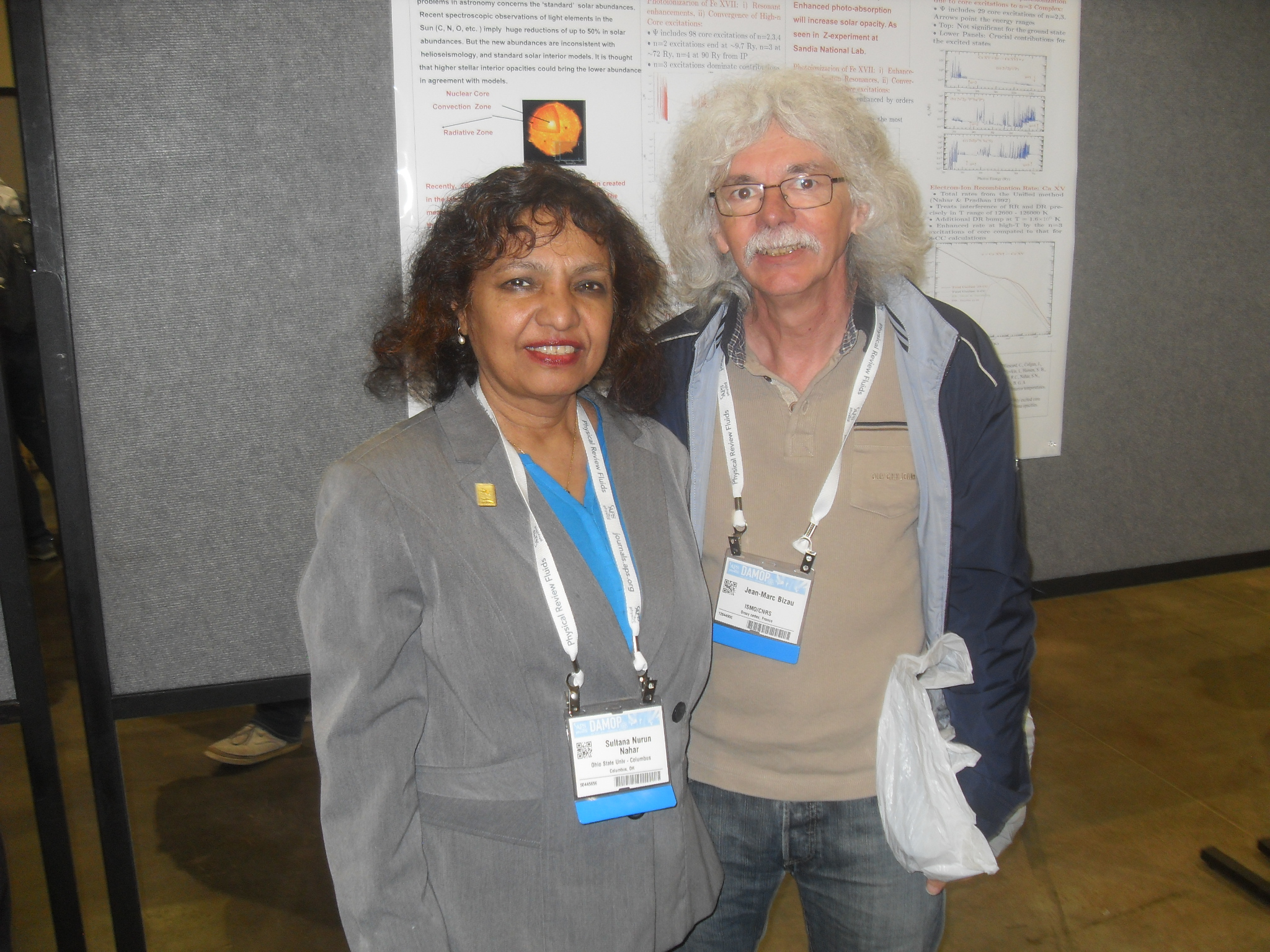
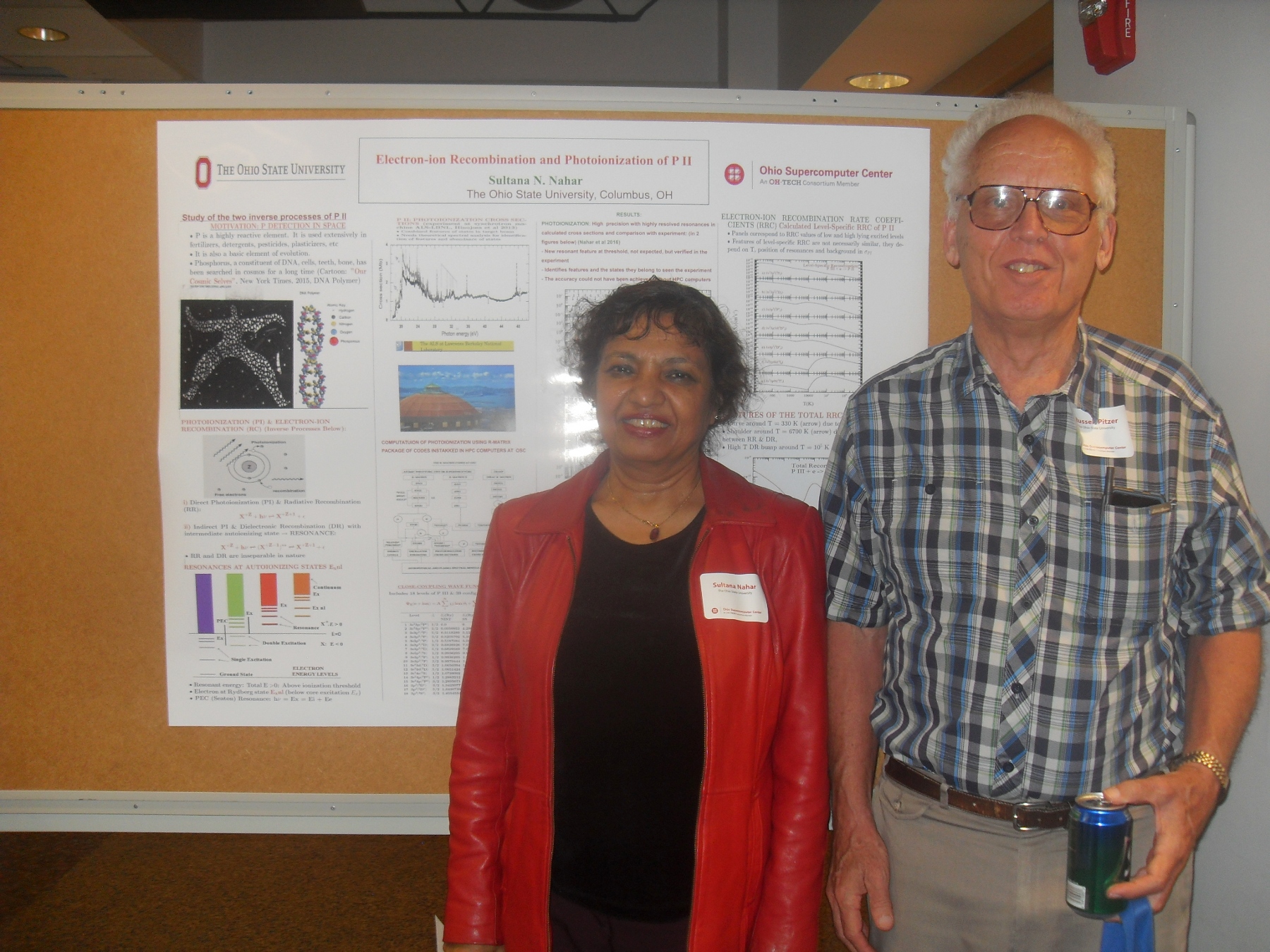
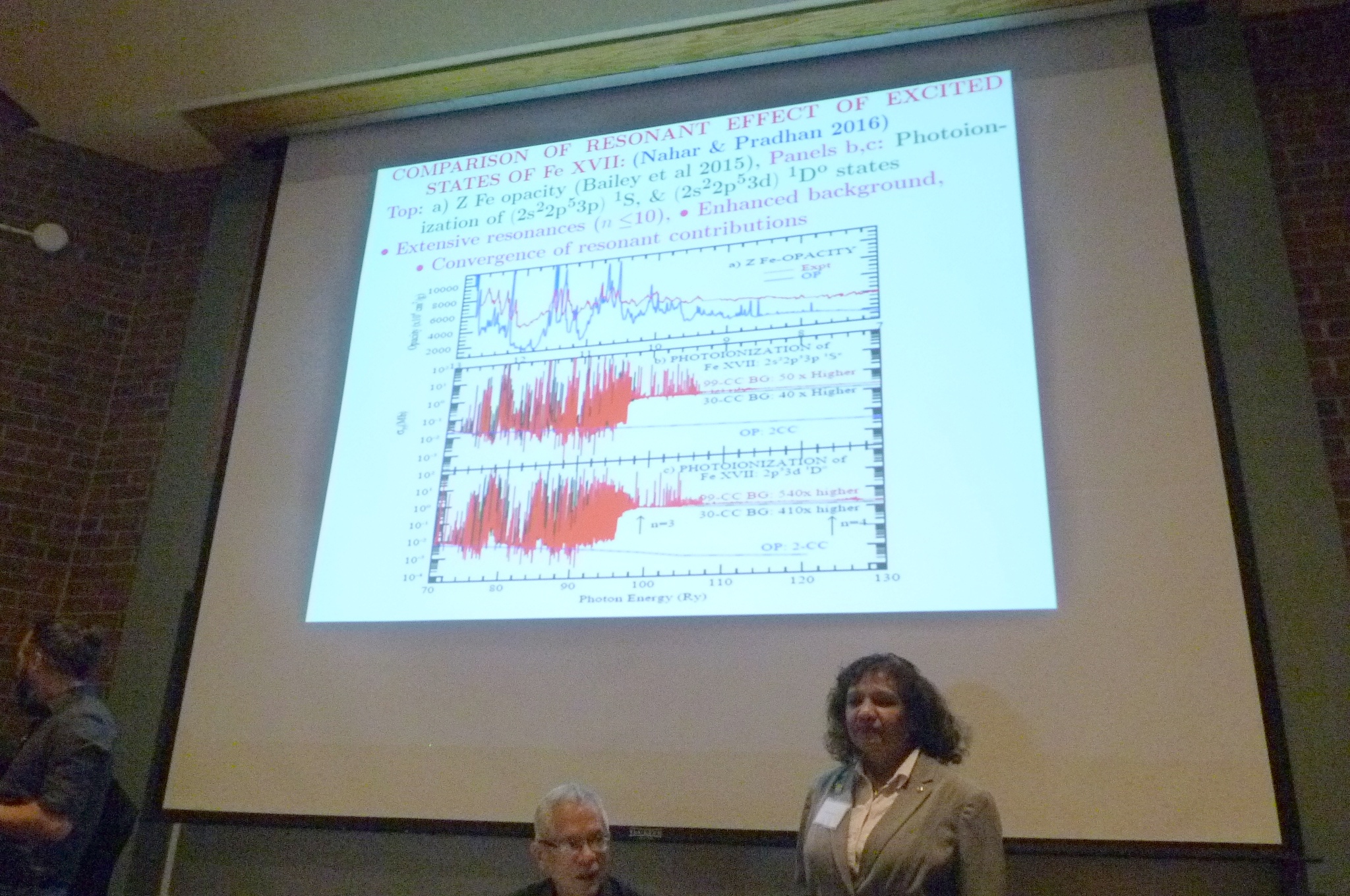
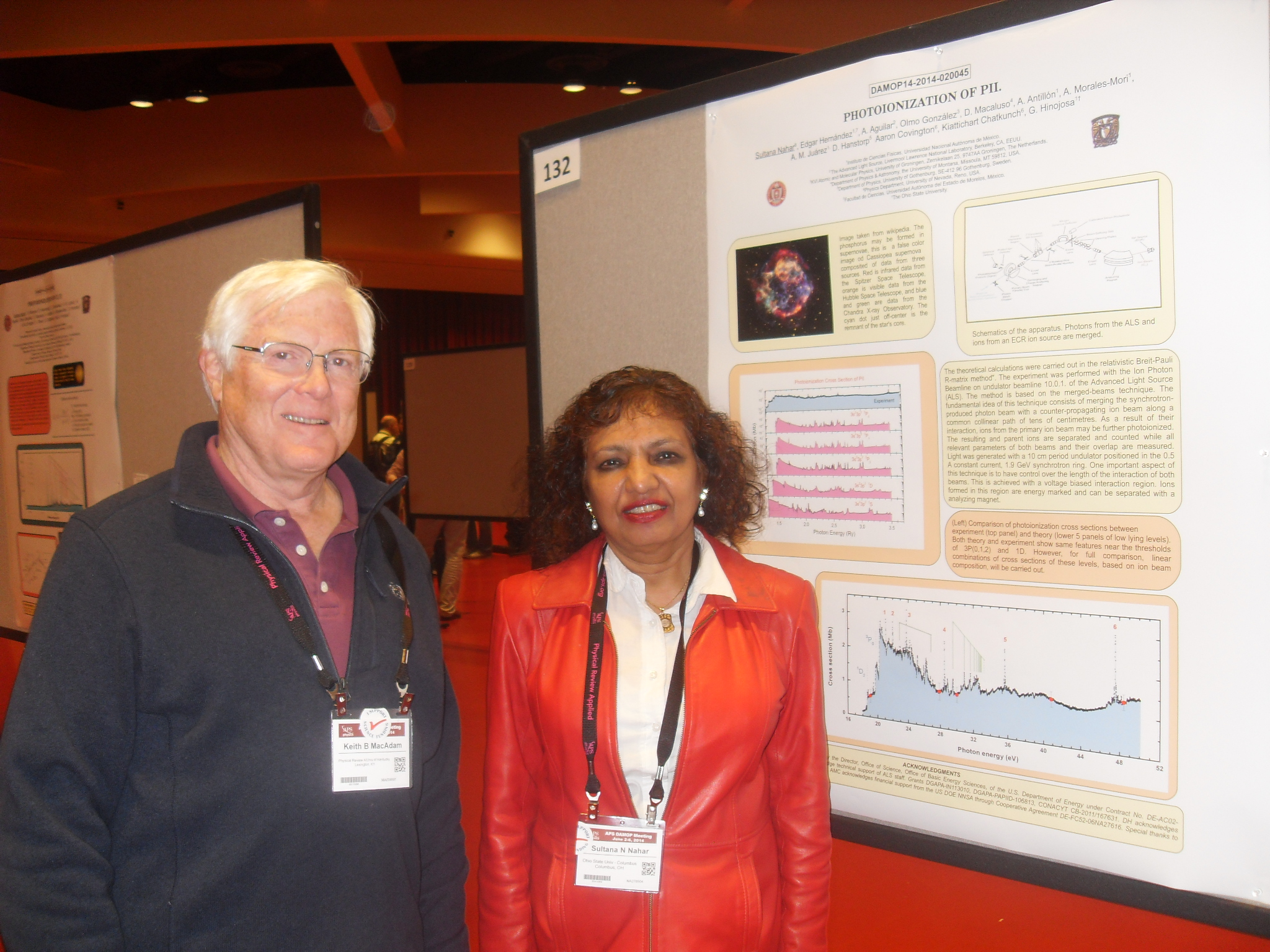
i) 2016: Past collaborator Dr. Jean-Marc Bizau, DAMOP, ii) OSC Presentation of photoionization of P II (a basic element of life)
(Sultana and Russ Pitzer), ii) 2017 Workshop on Astrophysical Opacities:
Fe XVII photoionization impact on solar opacity, iii) DAMOP 2014: Keith
MacAdam
Found number of prominent features in photoionization which are
described in text book "Atomic
Astrophysics and Spectroscopy (AAS)"
Description of the process: Photoionization
Publications in Photoionization/
Opacity/ Modeling
Cross sections available at
NORAD-Atomic-Data
Significant part of the work are carried out under the Opacity
Project and the Iron Project
Group Members (past and present):
Professor Anil K.
Pradhan, OSU, USA
Dr. Werner Eissner, University of Stuttgart, Germany
Dr. Claude Zeippen, Observatorie De Paris, France
Dr. Honglin Zhang, Los Alamos National Lab, New Mexico
Dr. Aaron Sigut, University of Western Ontario, Canada
Dr. Justin Oelgoetz, Austin Peay State University, Tennessee
Dr. Manual Bautista, Western Michigan University
Dr. Ron Phaneuf, University of Nevada
Dr. Aaron Covington, University of Nevada
Dr. Alex Aguiar, University of Nevada
Dr. Guillermo iHinojos, Universidad Nacional Autónoma de México
Dr. Jean-Marc Bizau, ISMO, Universite Paris-Sud, France
VahidReza Adineh, Iran
ELECTRON-ION RECOMBINATION & IONIZATION FRACTIONS:
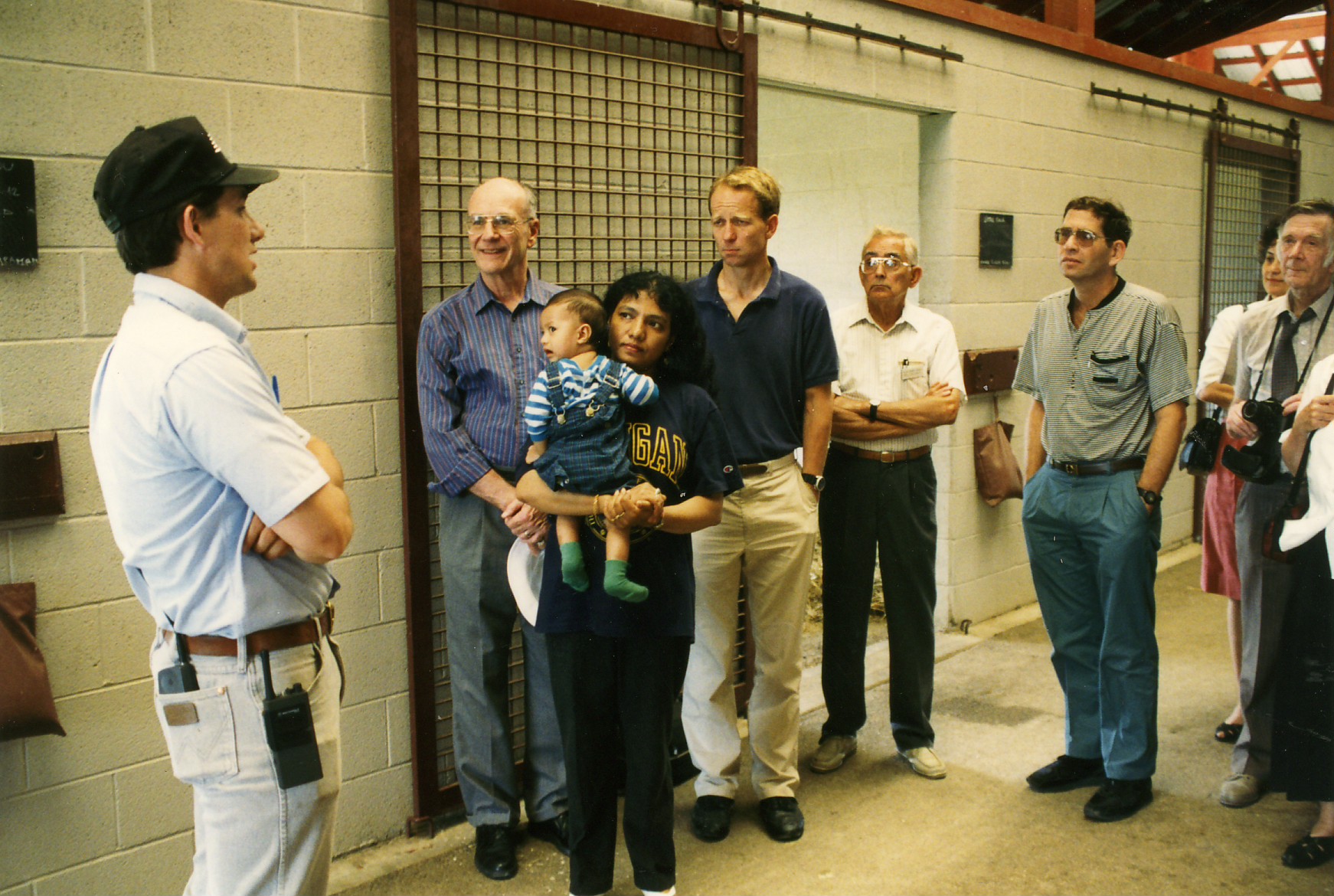
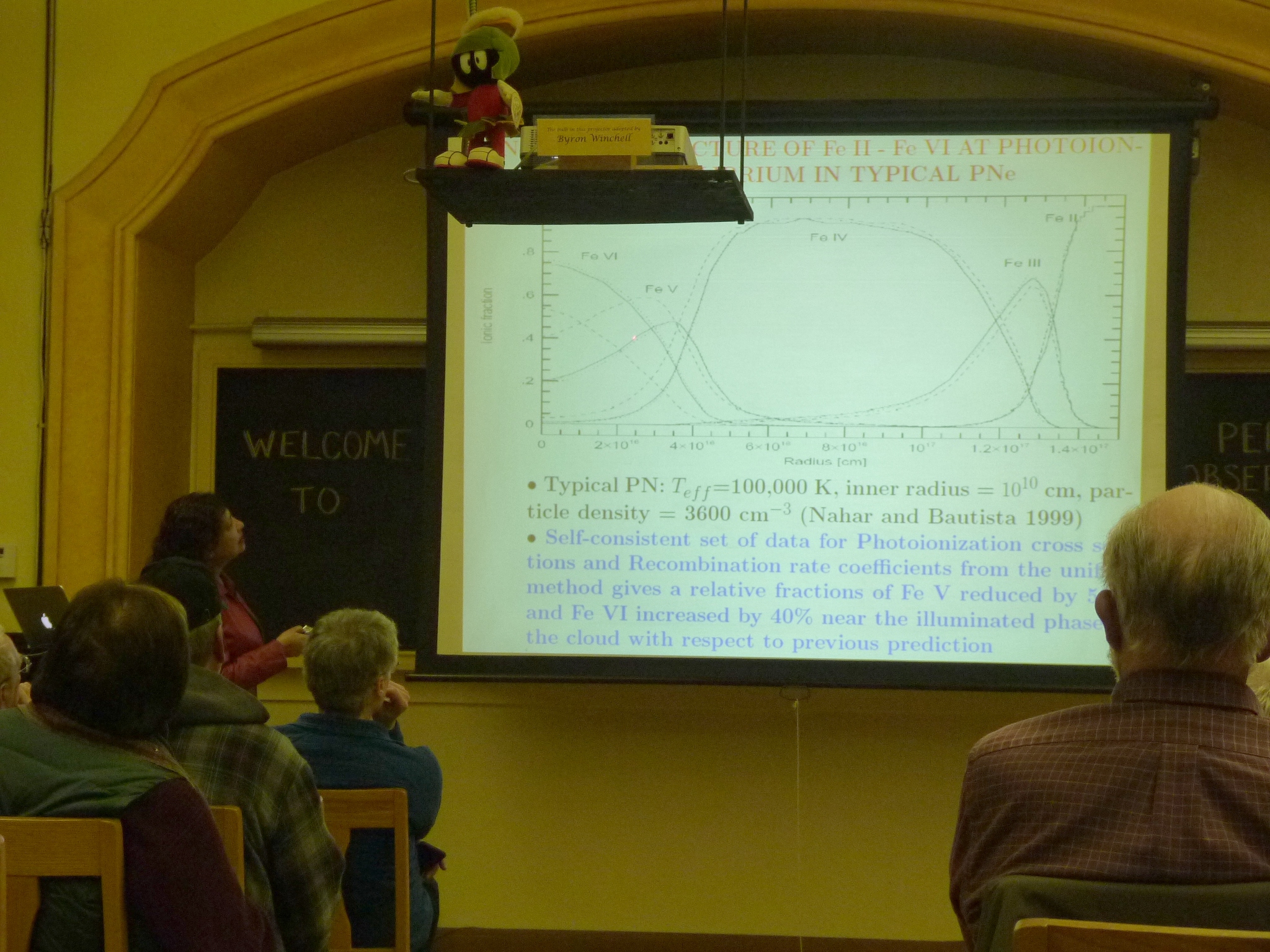
i) 1994: Stellar modeling, U of Kentucky, Mike Seaton and Osterbrock
Introduced with A.K. Pradhan "the unified method" for total electron-ion
recombination (see publications and book AAS)
- Lyman Spitzer's appreciation on unified method:
Letter 1,
Letter 2
Description of the process: Electron-ion
recombination
Publications in Electron-Ion Recombination
Cross sections, recombination rates available at
NORAD-Atomic-Data
Significant part of the work are carried out under the Opacity
Project and the Iron Project
Examples of invited presentations:
- Workshop: "Atomic
Physics in Astronomy", Honoring M.J. Seaton, ITAMP-HARVARD,
(2006): "The Iron
Project: Atomic Processes in Astrophysical Plasmas
Group Members (past and present):
Professor Anil K.
Pradhan, OSU, USA
Dr. Hong Lin Zhang, Los Alamos National Lab
Dr. Manual Bautista, Western Michigan University
RADIATIVE TRANSITIONS & KILONOVAE:
GRAVITATIONAL AND ELECTROMAGNETIC WAVES IN KILONOVA
GW201708, SPECTRA - RADIATIVE TRANSITIONS, LIFETIMES, & SPECTROSCOPY:
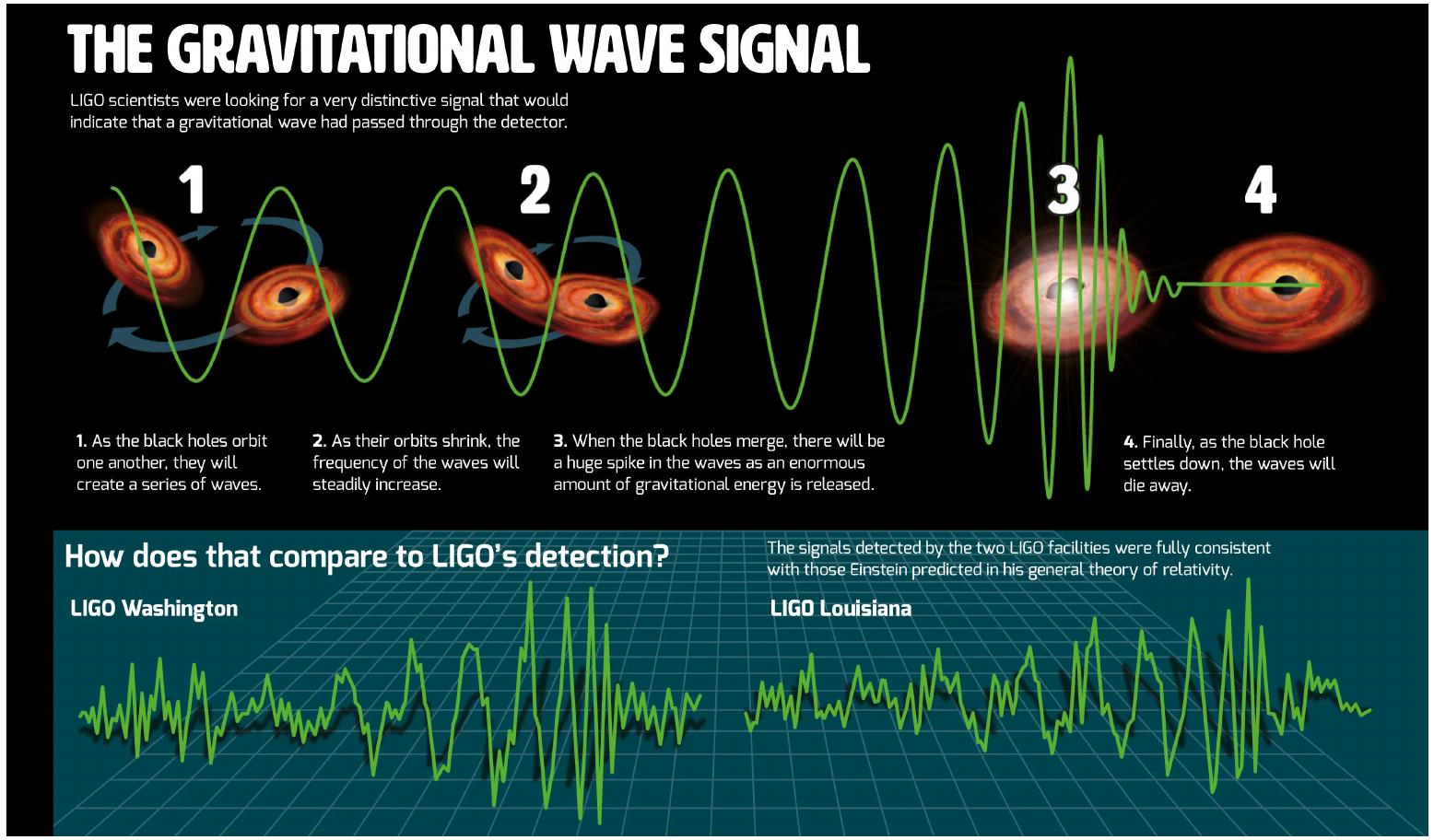
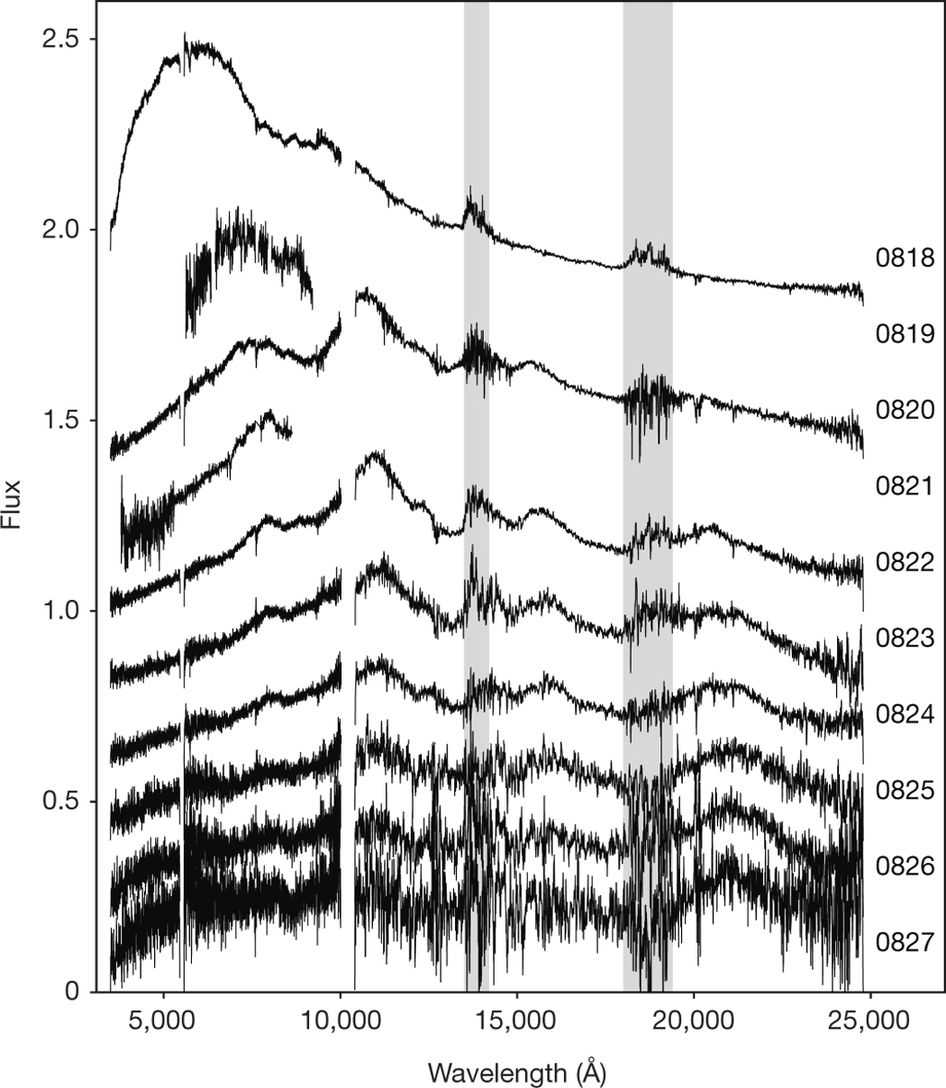
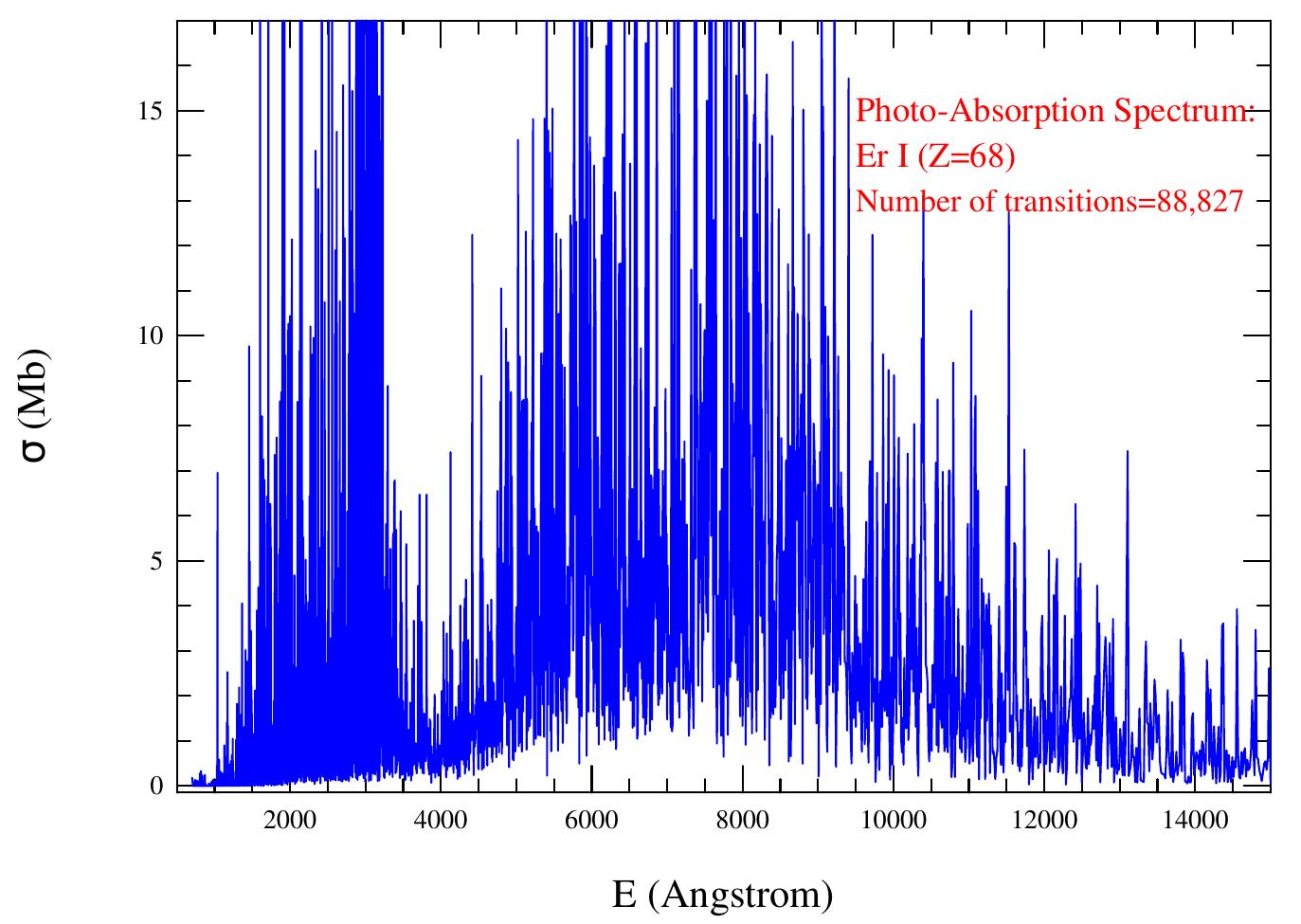
i) Graviational wave signal of a kilonova event when two black holes or
neutraon stars merge to form one. ii) Along with strong gravitational waves
the merger is found to create heavy elements through r-process. The figure shows
the electromagtic spectra with a broad emission bump, 3000 -7000 A, created by
merger GW201708. iii) The broad spectral feature of GW201708 indicates probable
creation of lanthanides that form broad spectra, eg.g. Er I (nahar 2024)
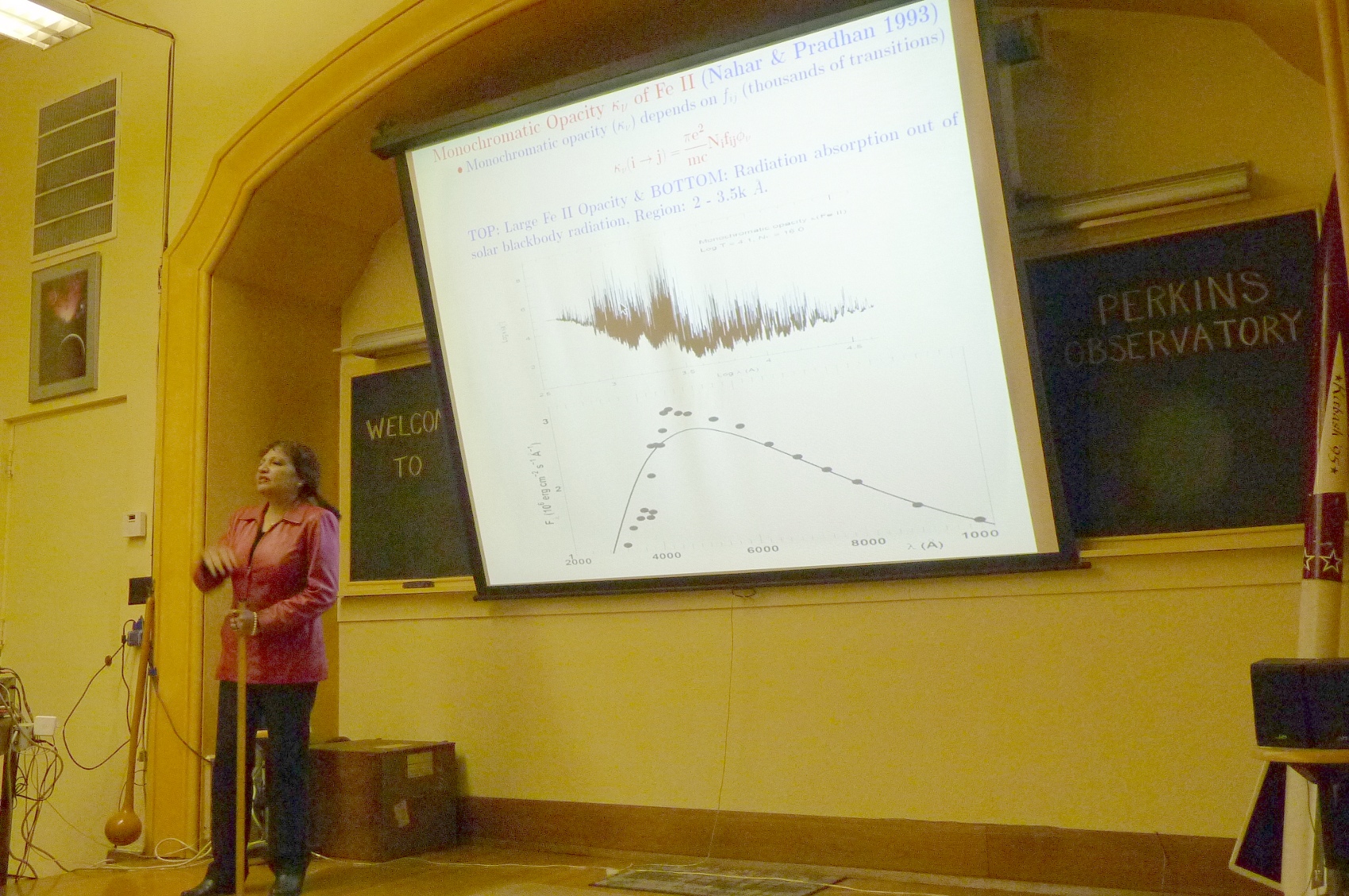
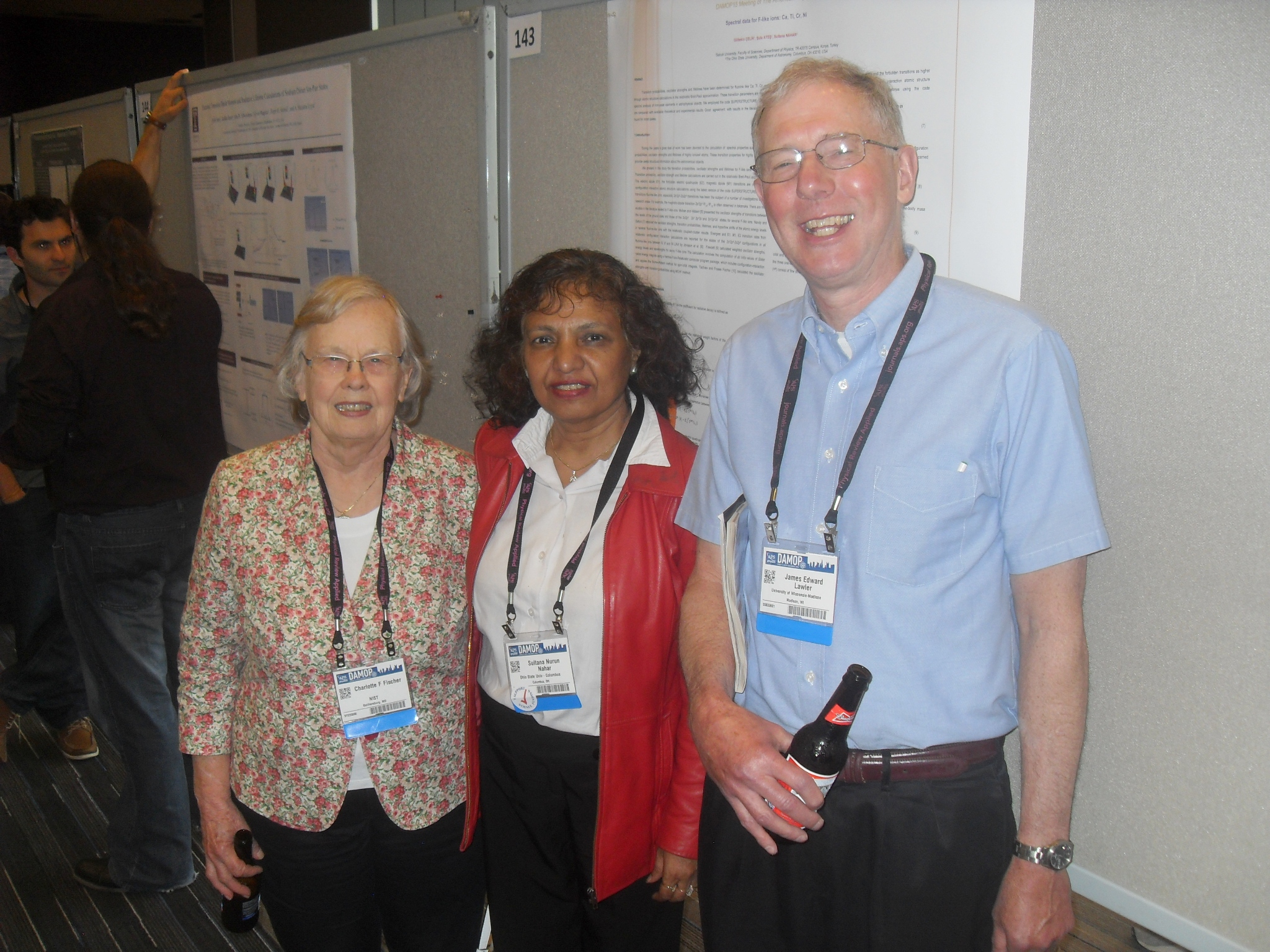
i) Slide shows interpretation of photoabsorption due to Fe II on Planck's
distribution curve of the sun, Perkins Observatory, Ohio, Jan 19, 2017
ii) 2015 DAMOP: Charlotte, Sultana, Jim - in radiative transitions poster
Developed spectroscopy for identifications of calculated levels
and transitions in R-matrix method (see publications and book AAS)
Description of the process: Radiative transition
probabilities
Publications in Radiative transitions
and lifetimes
Transition parameters (f,S,A), lifetimes are available at
NORAD-Atomic-Data
Significant part of the work are carried out under the Opacity
Project and the Iron Project
Group Members (past and present):
Professor Anil K.
Pradhan, OSU, USA
Dr. Werner Eissner, Stuttgart University, Germany
Dr. Franck Delahaye, Observatoire de Paris, Meudon, France
Dr. Chiranjib Sur, Shell Lab, India
Dr. Gouxin-Chen, ITAMP-Harvard
Dr. Gultekin Celik, Turkey
Dr. Sule Ates, Turkey
Dr. Akeel Hashem, Iraq
Mr. Luo Yi,
Mr. J. Peng
Mahmudul Hasan, Bangladesh
Dr. Tahmina Ferdous, Bangladesh
Dr. Betul Ataly, Turkey
DIELECTRONIC SATELLITE (DES) LINES & ASTROPHYSICAL MODELING:
With A.K. Pradhan developed method to obtain detailed features with
natural broadening of DES lines, not obtained in isolated resonance method.
Description of the process: Di-electronic
satellite lines
Detailed theory:
Dielectronic Satellite Lines
Publications in DES lines and astrophysical
applications
The method is based on extension of the Unified Theory for total electron-ion
recombination.
Group Members (past and present):
Professor Anil K.
Pradhan
Dr. Ramadan Semida, Egypt
ELECTRON-IMPACT EXCITATION (EIE) & LINE RATIOS:
Employ relativistic Breit-Pauli R-matrix (BPRM) method to calculate
collision strengths for EIE and study features with high accuracy for
solution of abundance problems in this plasma (see publications and book AAS)
Description of the process:
astrophysical background, process,
and features of collision strengths: ex. Ne V
Theory: Electron-ion scattering and
line ratios
Publications on collision strengths and line
ratios
Limited number of collision strengths are available at
NORAD-Atomic-Data
Studied oxygen and neon for planetary nebulae, ULIRG
Group Members (past and present):
Professor Anil K.
Pradhan
Dr. Werner Eissner, Stuttgart University, Germany
Dr. Maximiliano Montenegro, Catholic University of Chile
Ethan Palay, Colorado School of Mines
Michael Dance, University of North Carolina
Hala, OSU and Aligarh Muslim University
Yasin Gokce, Turkey
Dr. Lotfia El Nadi, Egypt,
EXO-PLANETARY RESEARCH: Phosphorus
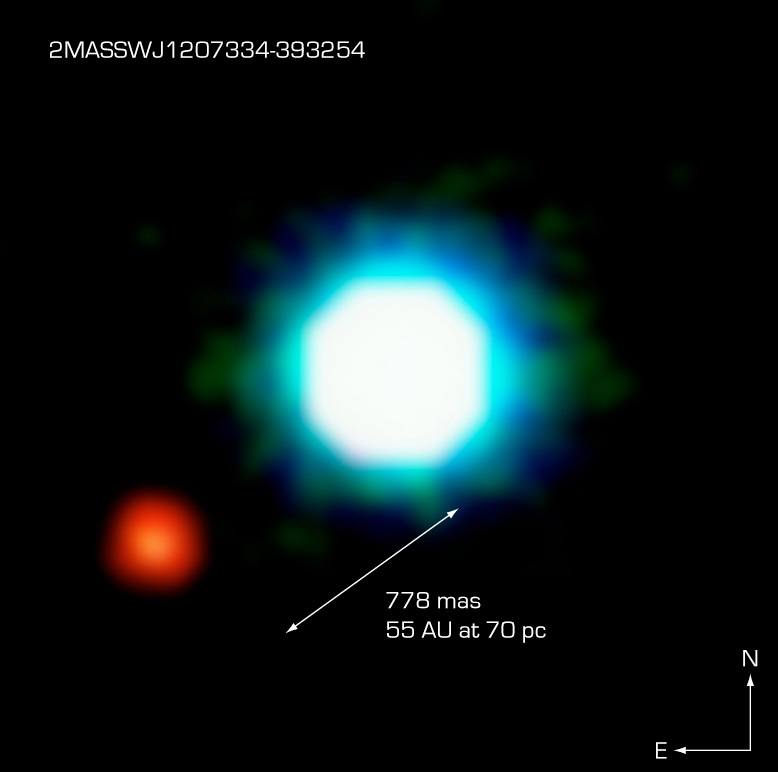
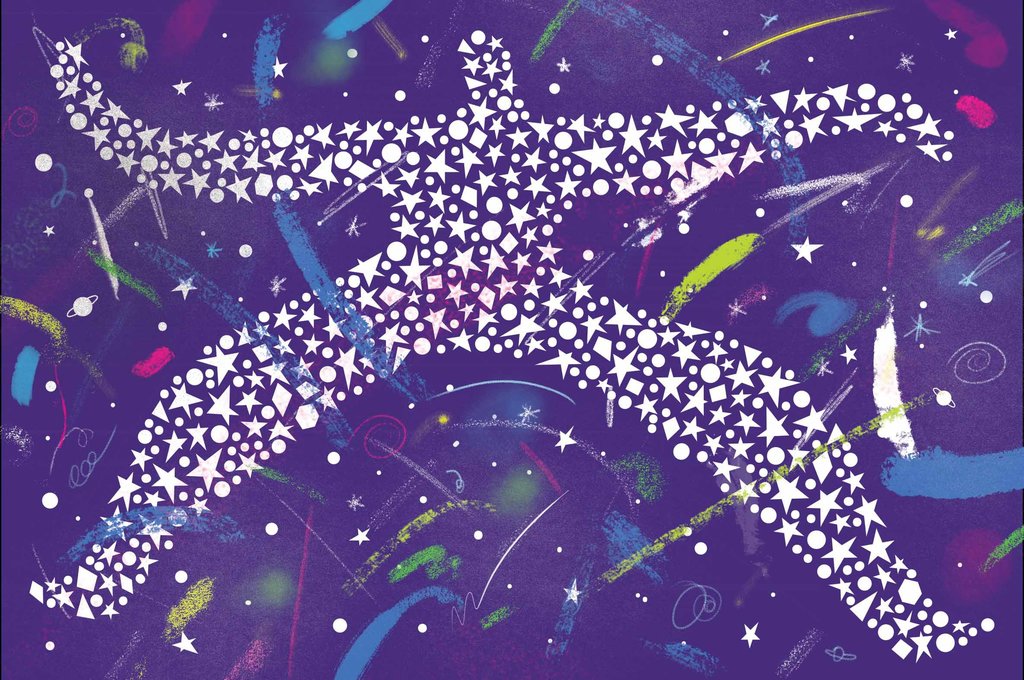
i) The first direct detection of an exoplanet, exoplanet2M1207b-ESO2004, in
2004. ii) Carl Segan popularize "We are made of star dusts", line of a popular
song. We find all our body elements scattered in the space and all of them
have astronomical origin (Cosmic self cartoon, New York times 2015)
Although phosphorus (P) is a basic element of life, contained in DNA/RNA,
we find very little P in space raising the question - is this the reason
for not finding any lifeform out there?
OUR PROJECT:
To study and give spectroscopic features of P ions
that can facilitate the search through telescopes and identify of its
existence in the astronomical objects, particularly in exoplanetary
systems where lifeforms can be found.
An overview public presentation "EXTRATERRESTRIAL
LIFE: PHOSPHORUS", S.N. Nahar, Perkins Observatory, Delaware, Ohio,
2020
PUBLICATIONS ON P:
"Collision
strengths for FIR and UV transitions in P III and the phosphorus
abundance", Rahla Naghma, Sultana N. Nahar, Anil K. Pradhan,
MNRAS Lett 479, Issue 1, L60-L64 (2018)
``Photoionization and electron-ion
recombination of P~II", S.N. Nahar, MNRAS 469, 3225¿3231 (2017)
``Photoionization of P+: Experiment and
Theory", S.N. Nahar, E. M. Hern\'andez, L. Hern\'andez, A. Antill\'on, A.
Morales-Mori, O.
Gonz\'alez, A. M. Covington, KC Chartkunchand, D. Hanstorp,
A. M. Ju\'arez, G. Hinojosa, JQSRT 187, 215-223 (2017)
``Photoionization cross sections of ground
and excited levels of P II", S.N. Nahar, New Ast. 50, 19-24 (2017)
PRESENTATIONS (partial list):
Title (keynote): "Spectra of Phosphorus
for Astrophysical Modeling",
S.N. Nahar (co-authors: B. Shafique, M. Rothman, R. Naghma), 2nd International
Conference of Molecular Modeling and Spectroscopy, National Research Centre,
Egypt. Sep 23-24, 2020
Invited talk: "Mystery
of extra-terrestrial life with phosphorus",
S.N. Nahar, AMU Centenary Webinar on
"Prospects of STEM
Education in 21st Century and Contributions of Women Scientists in STEM",
Sultana N. Nahar, Indo-US APJ Abdul Kalam STEM Education and Research Center
of OSU-AMY, India, October 13-14, 2020
Ttile (public): "Physics of
phosphorus for a clue for extra-terrestrial extra-terrestrial life",
S.N. Nahar, International webinar
on Physics, Pabna University of Science
and Technology (PUST), Pabna, Bangladesh, Oct 1, 2020. (audience.from
universities in Bangladesh and India)
Abstract: F03.00001: "Xray
to far infrared spectrum of phosphorus \for astrophysical modeling", S.
Nahar, B. Shafique, M. Rothman, R. Naghma,
APS Ohio Section Fall 2020 Meeting, October 16¿17, 2020; VIRTUAL from Ohio
Abstract: J03.00008 : "Application
of Monte Carlo Method to Simulate Radiation Transfer through Exoplanetary
Atmospheres", Michael Rothman,
A. Pradhan, S. Nahar, B. Shafique, K. Hoy, APS Fall 2021 Meeting of the
Eastern Great Lakes Section (EGLS), November 12-13, 2021
NANO-BIOMEDICINE:
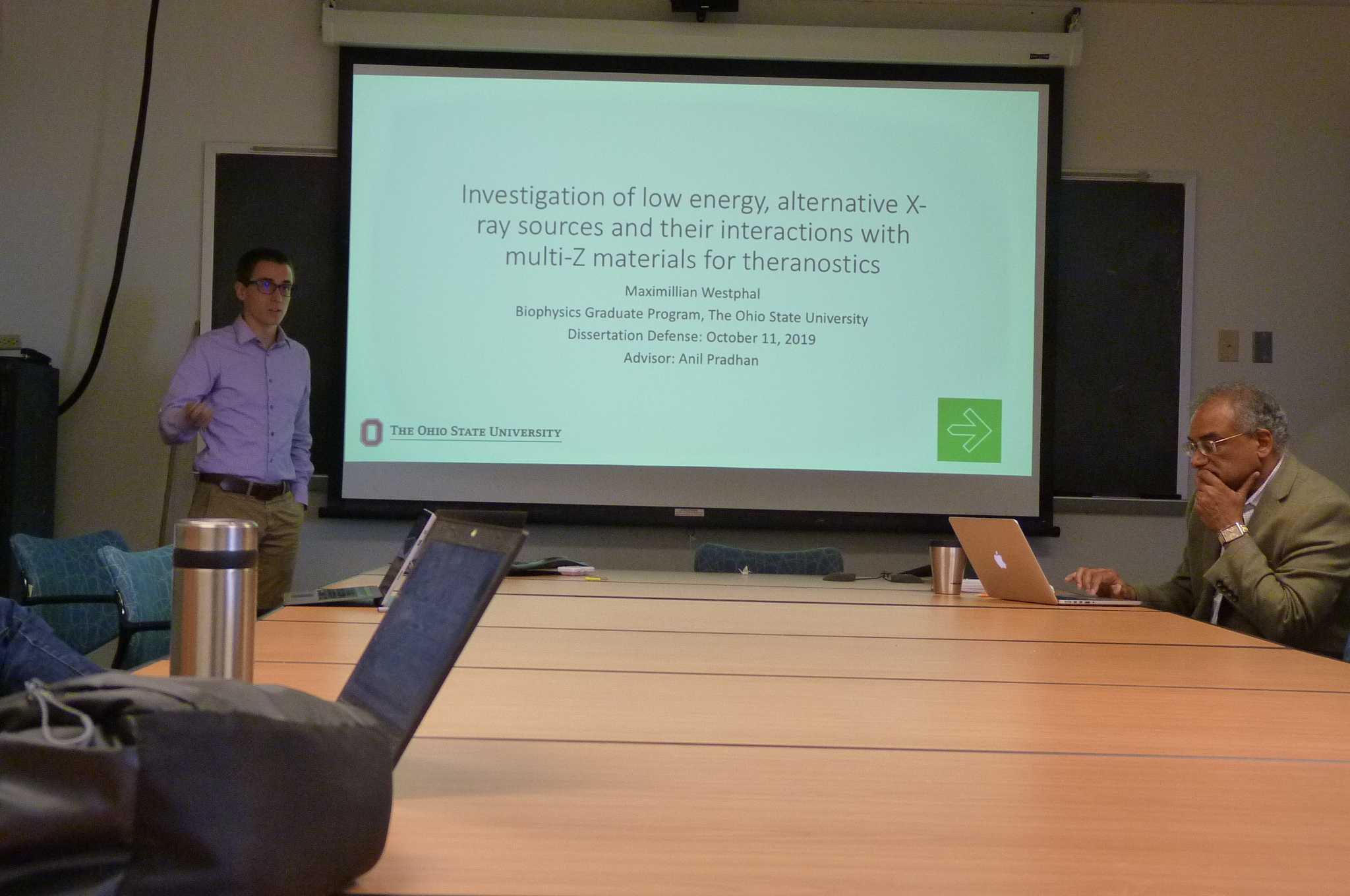
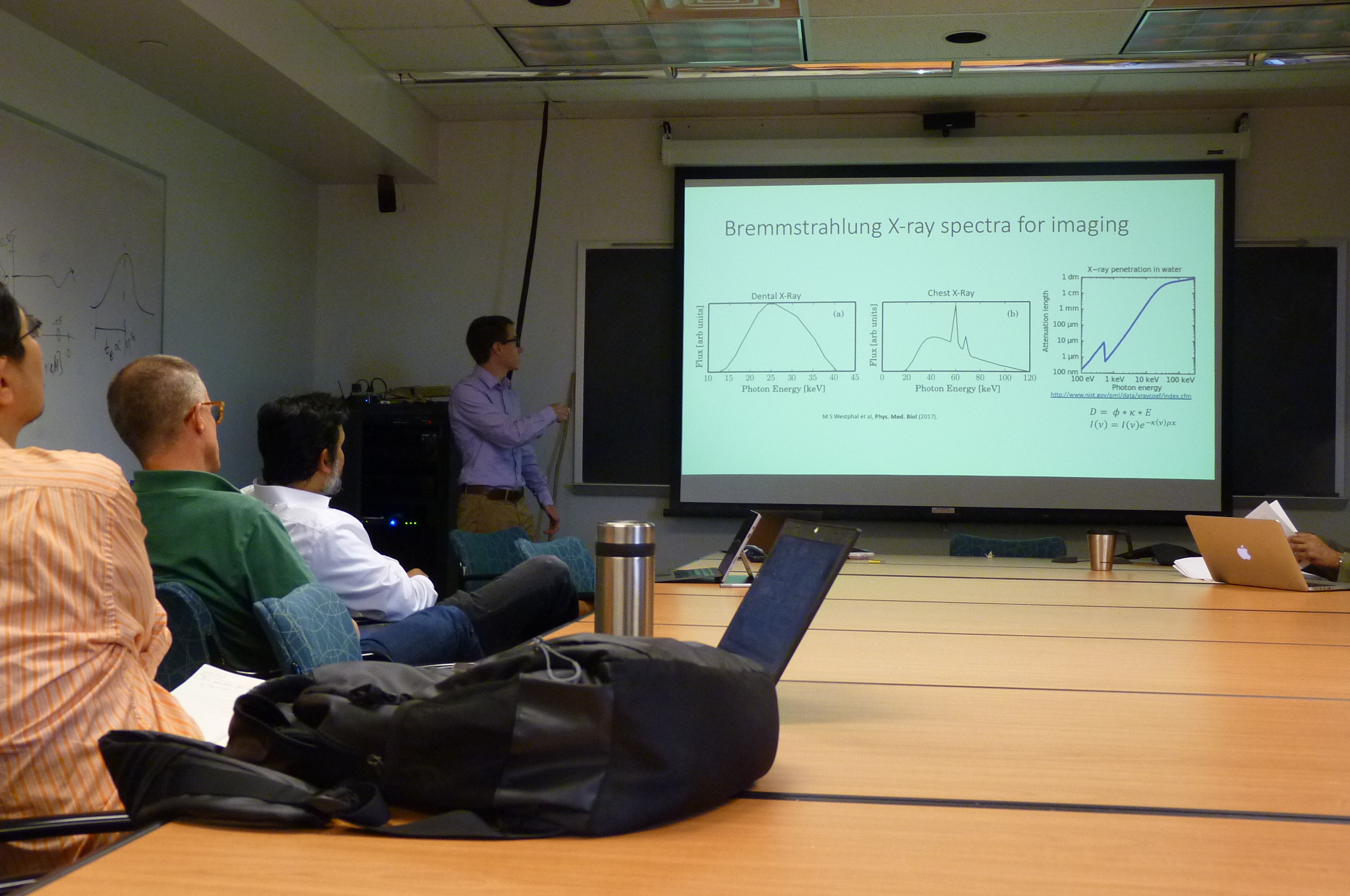
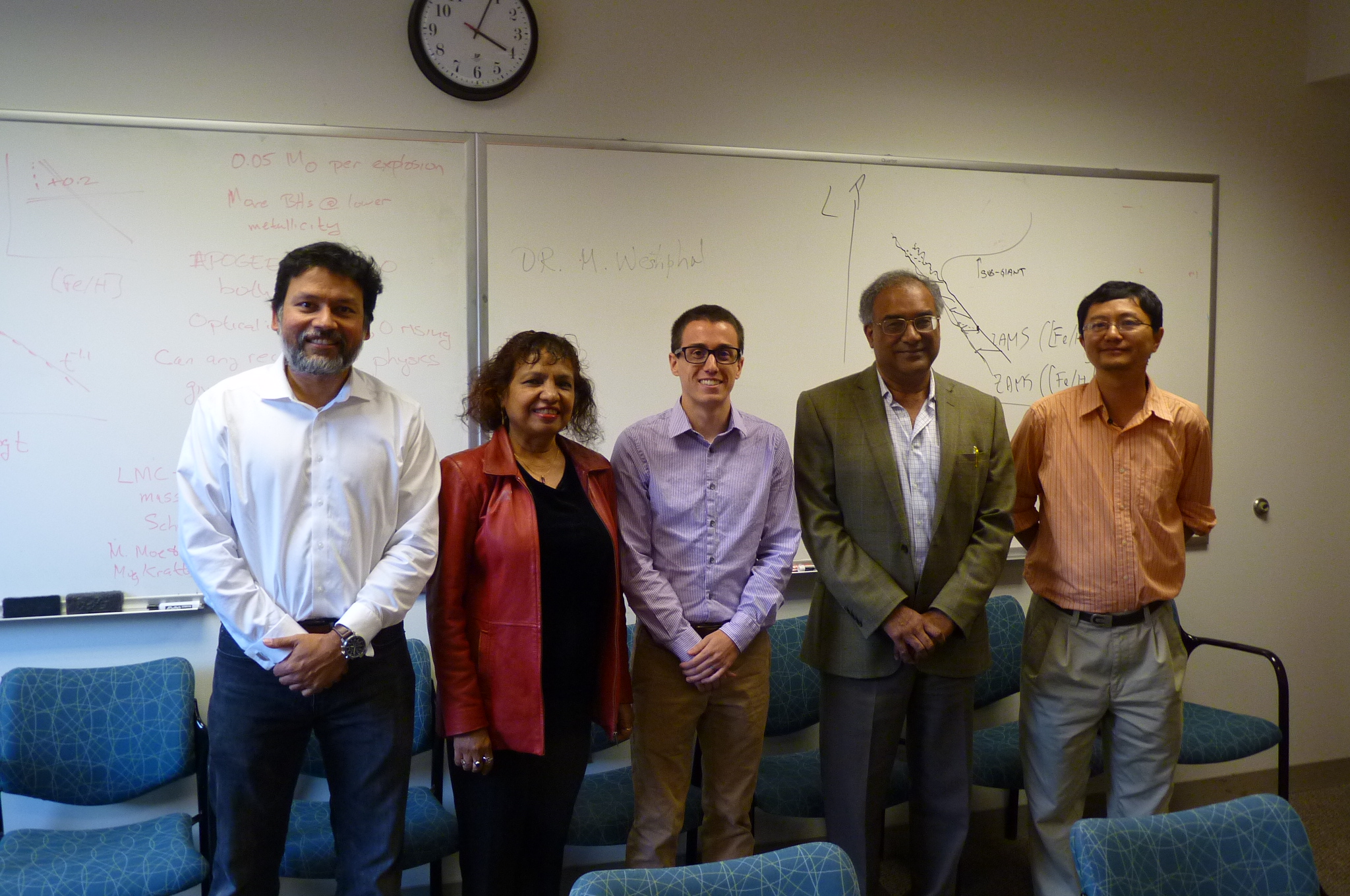
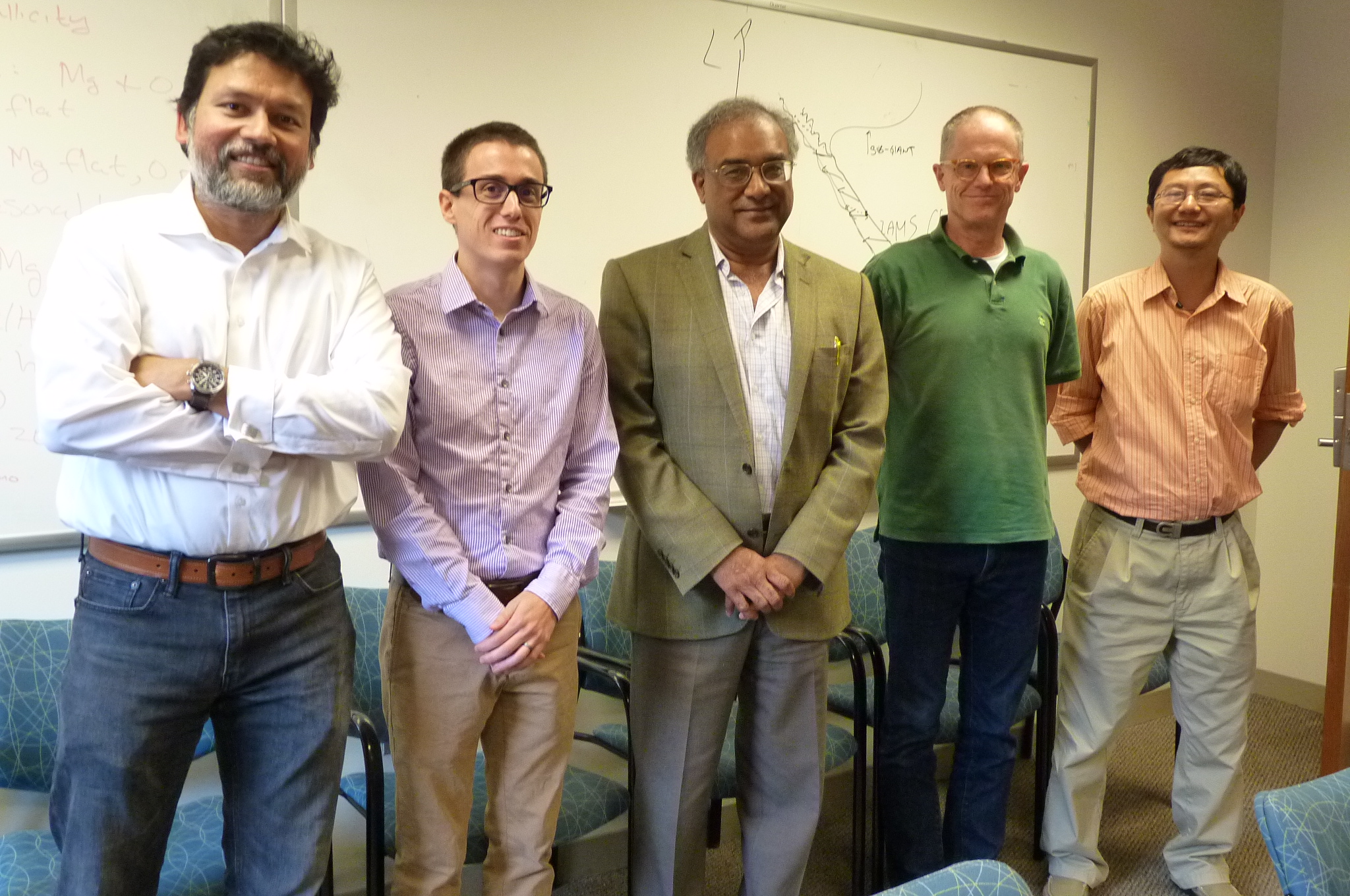
Oct 11, 2019: Maximilano Westphal receives his Ph.D. under Biophysics
- i,ii) Ph.D. thesis presentation
- iii,iv) Dr. M. Westphal with committee
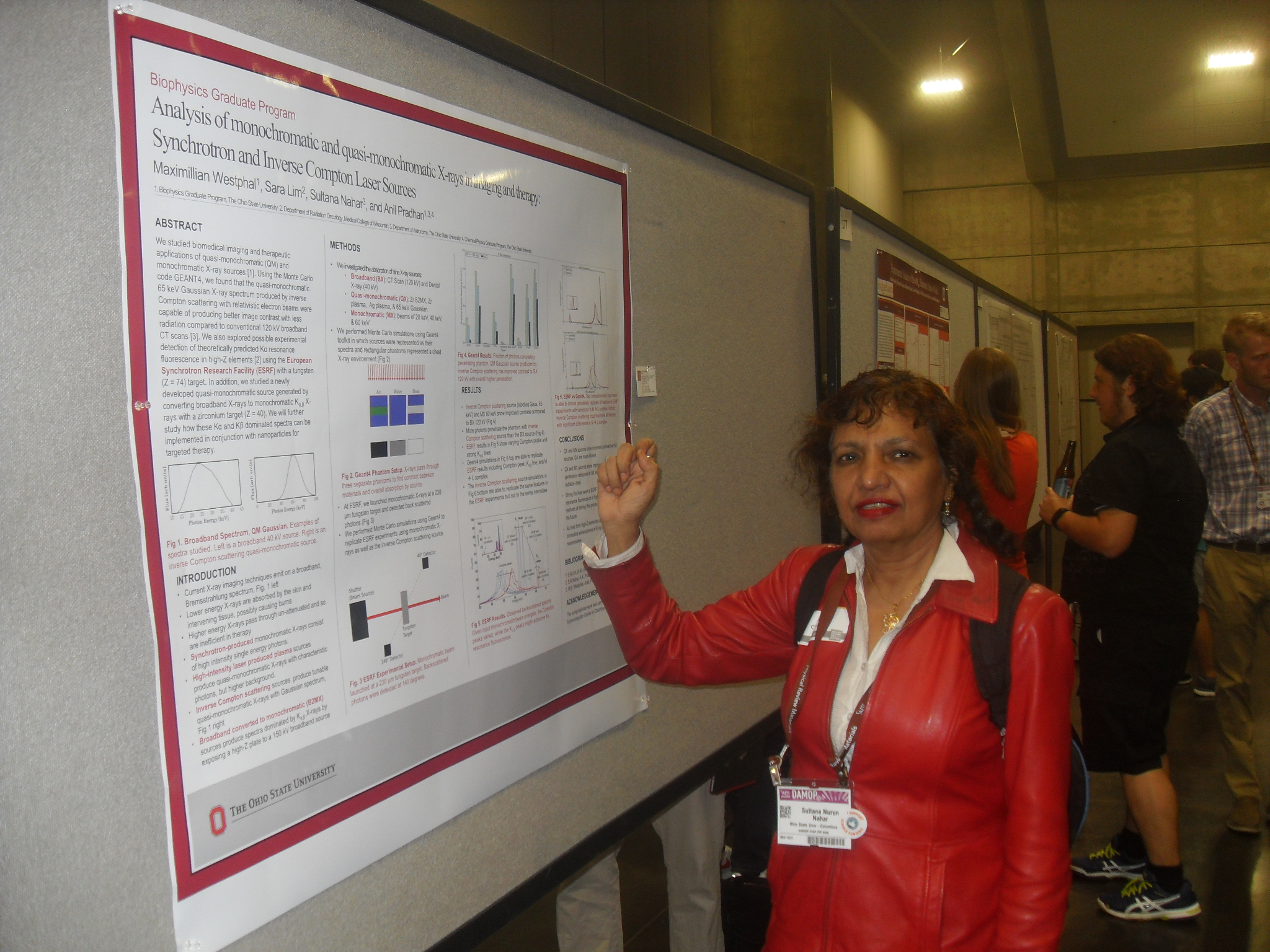
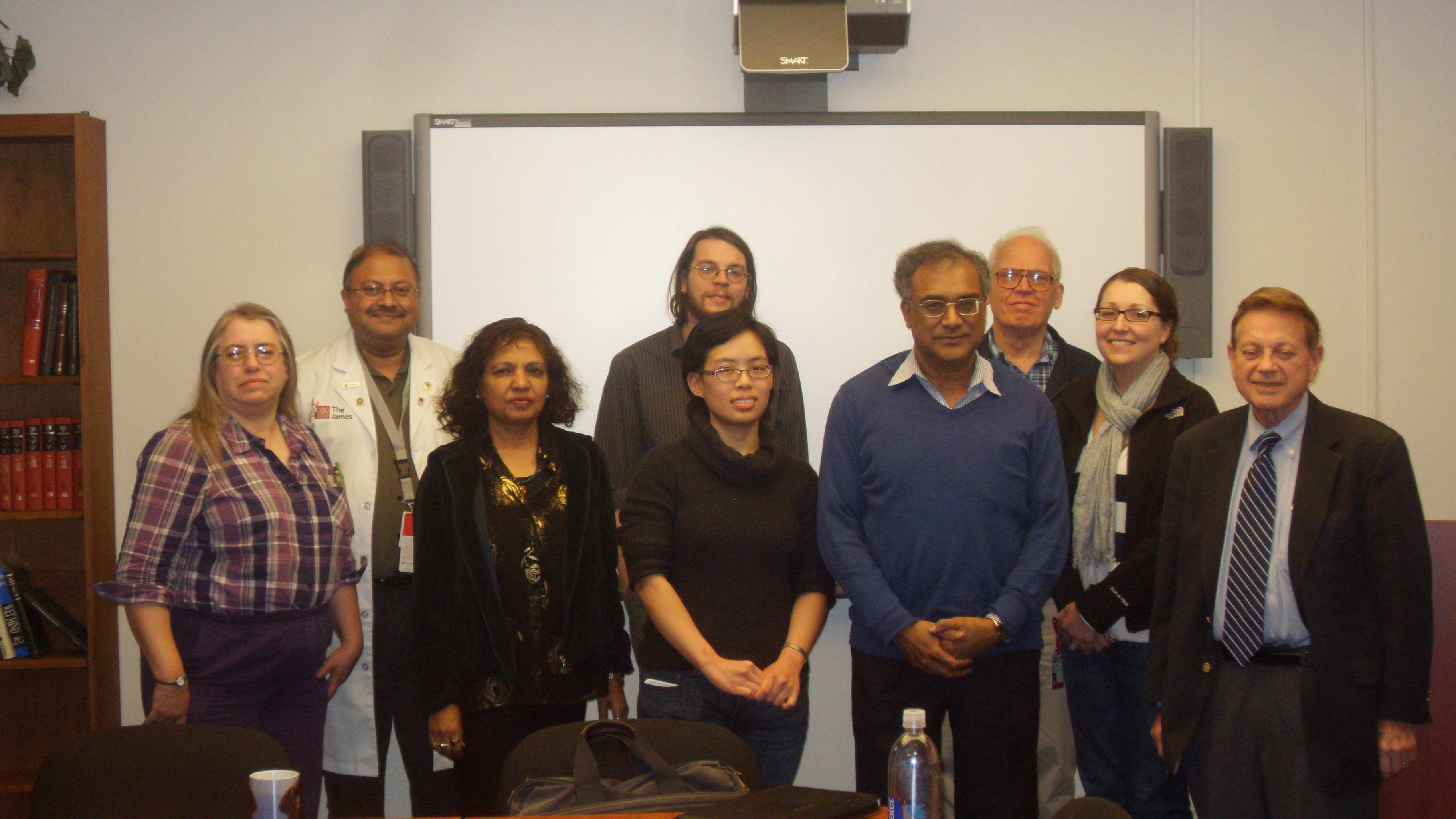
- L: Presentation of "Monochromatic X-rays for Cancer Theranostics", i)
DAMOP 2017, ii) SUG Meeting
of OSC, Columbus, Dec 3, 2015, R: Biomed group picture 2013
Proposed with A.K. Pradhan and Yu Yan, the new method "Resonant
Nano-Plasma Theranostics (RNPT)" for cancer treatment - based on narrow
band x-ray spectroscopy
Co-leader: Multi-disciplinary
Biomedical
Nanoscience program on RNPT:
Astronomy, Physics, Chemistry, Pathology, Radiation Oncology
Description of the method:
RNPT
Publications on RNPT
- RNPT Research Activities and Publications
RNPT is referred to as one of the four important contributions of
astronomy to human life: GPS, wireless internet, RNPT, and laser eye surgery
(Astronomy magazine, May 2012,
p.31-35).
Chapter 5: "Dreaming of the
Star Treatment" in the book "Science Unshackled" (Renee James, Fall 2014,
Johns Hopkins U press)) describes astronomical study and how it leads to
RNPT for cancer treatment and includes section 35 "The Iron Lady and the
Gold Standard"
Examples invited presentations:
- Intl Symp on Molecular Spectroscopy, Session honoring R.M. Pitzer, Ohio
State University, 2008:
"ATOMIC SPECTROSCOPY: ASTRONOMY TO BIO-MEDICAL SCIENCE"
Group Members (past and present):
Professor Anil K.
Pradhan, OSU, USA
Dr. Yu Yan, Radiation Oncology, Thomas Jefferson University
Dr. Maximiliano Montenegro, Catholic University of Chile
Dr. Jian Wang, Radiation Oncology, OSU
Dr. Rolf Barth, Pathology, OSU
Dr. Sara Lim, Wisconsin Medican Institute
Max Westphal, Biophysics, OSU
Dr. Russel M. Pitzer, Chemistry, OSU
Dr. Claudia Tarra, Chemistry, OSU
Dr. Enam Chowdhury, Physics, OSU
Dr. Erica Bell, Radiation Oncology
Dr. Arnab Chakroborty, Radiation Oncology
Dr. Nilendu Gupta, Radiation Oncology, OSU
Recognitions
ELECTRON, POSITRON SCATTERING & SPIN POLARIZATION:
Wrote one extensive code for Dalitz integrals for positronium formation.
Also wrote one code for electron-positron scatterings from atoms and
spin polarization parameters during Ph.D. work and some continuation.
Description of the method:
for positronium formation &
for scatterings and spin polarization
Publications on electron, positron scatterings
and spin polarization
The original and modified code for electron-positron scatterings from
atoms and spin polarization parameters is used by many researchers in India.
Group Members (past and present):
Dr. J.M. Wadehra: Wayne State University
Dr. A.N. Tripathy, Roorkee Institute of Technology, India
DATABASES and NORAD-ATOMIC-DATA UNDER THE OP AND IP:
Extensive calculations and computations resulted in 4 databases, They are:
Atomic Data: Energy levels, Oscillator Strengths, Photoionization Cross
Sections
TOPbase at CDS
Atomic Data: Collisional Excitation, and Radiative Processes (include
fine structure)
TIPbase at CDS
Latest Atomic Data: Energy levels, Oscillator Strengths, Photoionization Cross Sections, Recombination cross sections and rate coefficients, Collision
strengths, Lifetimes
NORAD-Atomic-Data
Monochromatic opacities and program for mixtures
OPServer at Ohio Supercomputer
Center (OSC)
RESEARCH ACTIVITIES ARE LISTED IN
"Presentations"
Co-supervision of research projects of graduate students, post-doctoral
fellows, Astronomy Dept, OSU (1991 - present)
- OSU: Dr. Rahla Nagha, Dr. Hala, Dr. Max Westphal, Dr. Lianshui Zhao, Dr.
C. Sur, Ethan Palay, Dr. G.X. Chen, J. Peng, Luo Yi,
Dr. M. Bautista, M. Dance, Dr. M. Montenegro, Dr. Sara Lim, Yasin Gokce
- International: Dr. Akeel Hashem (Iraq), Dr. Betul Ataly (Turkey),
Dr. Gultekin Celik (Turkey), Mr. Mahmudul Hasan (Bangladesh), Dr. Ramadan
Semida (Egypt), Dr. Sule Ates (Turkey), Dr. Tahmina Ferdous (Bangladesh),
Vahid Reza Adineh (Iran), Arun Goyal (India), Mayank Dimri (India)
- Overseeing Research Advisor under OSU Obama-Singh STEM
Faculty Training Project, 2013 - 2017: 8
Asim Rizvi (Radiology), Malik Azeem (Molecular Genetics), Nida Rehman
(Radiology), Pervez Alam (Nanobiotechnology), Swaleha Naseem (Physics),
Taqseer Khan (Mathematics). Hala (Physics)
Some event pictures:
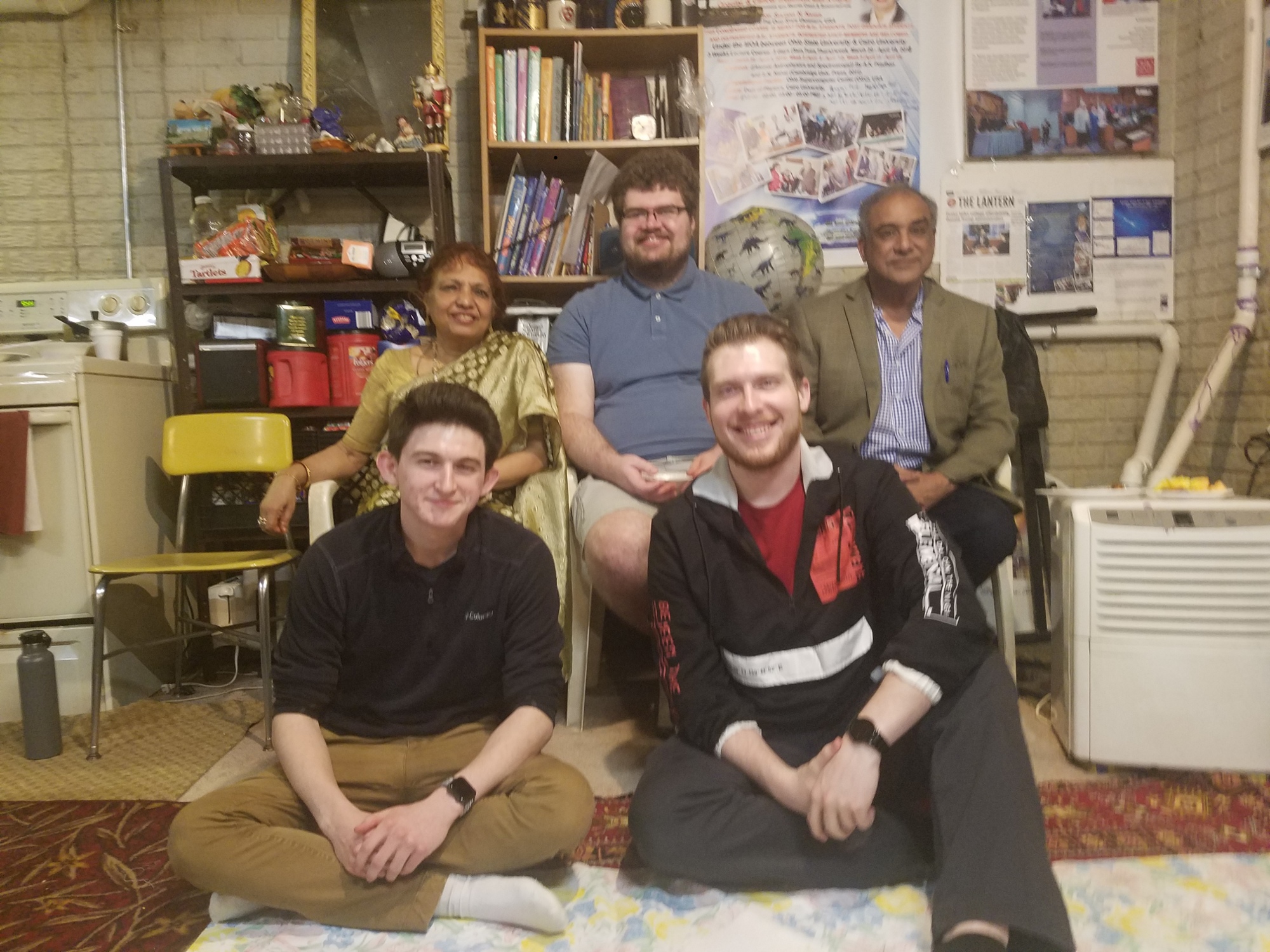
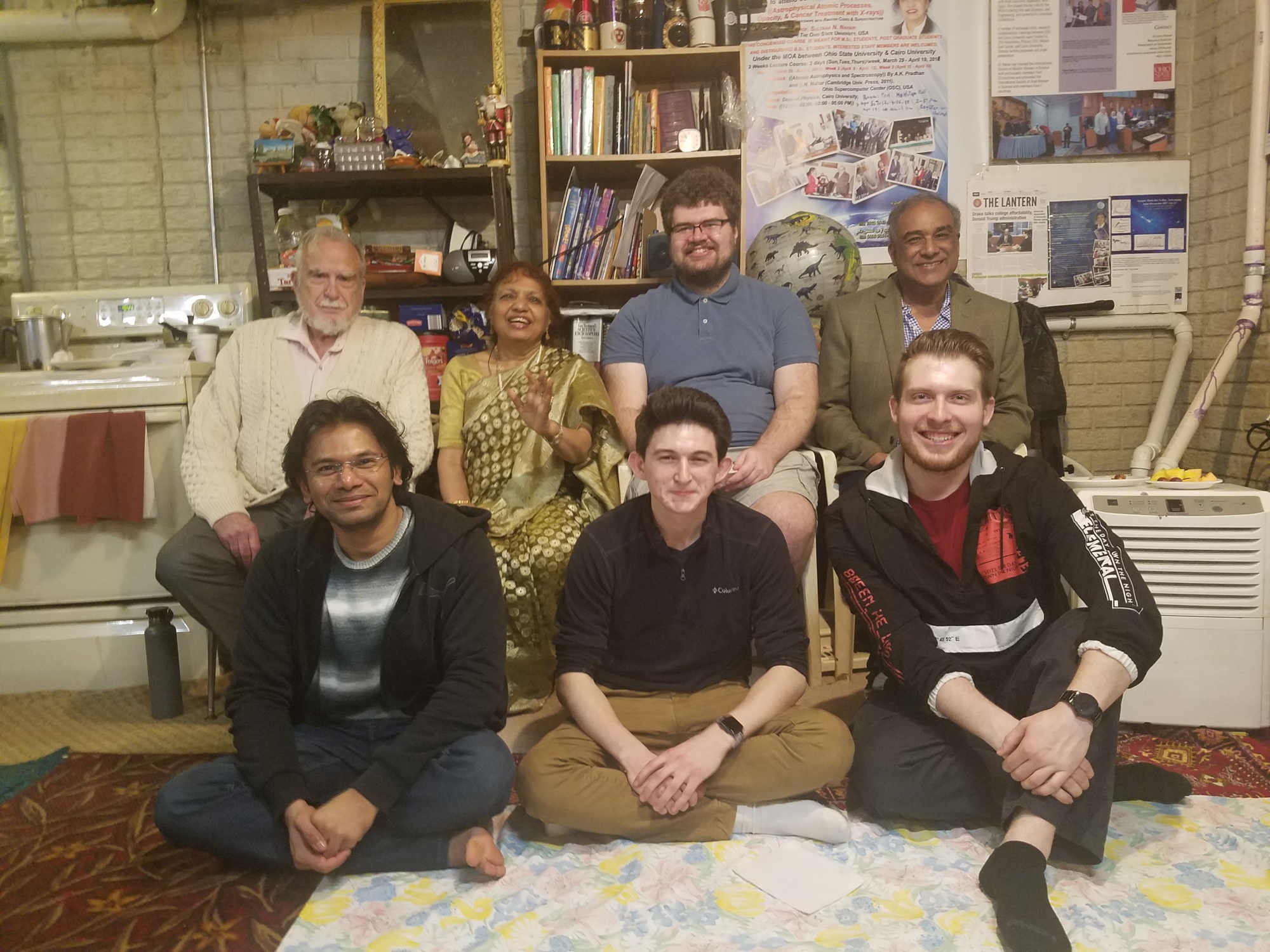
i) Group, April 2022: F: Mitchell Button, Michael Rothman, B: Sultana, Kevin Hoy.
Anil Pradhan, ii) Astronomy group
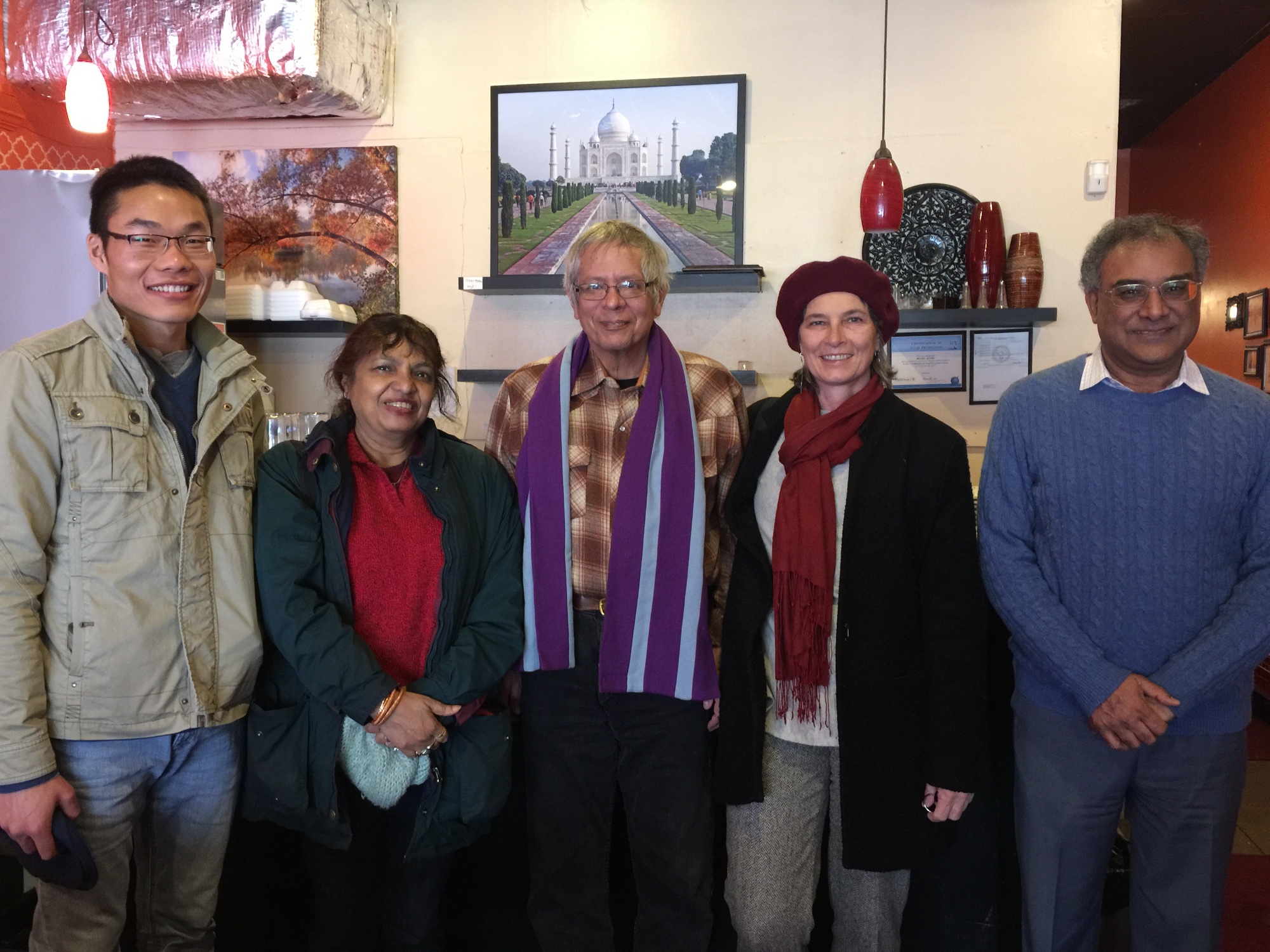
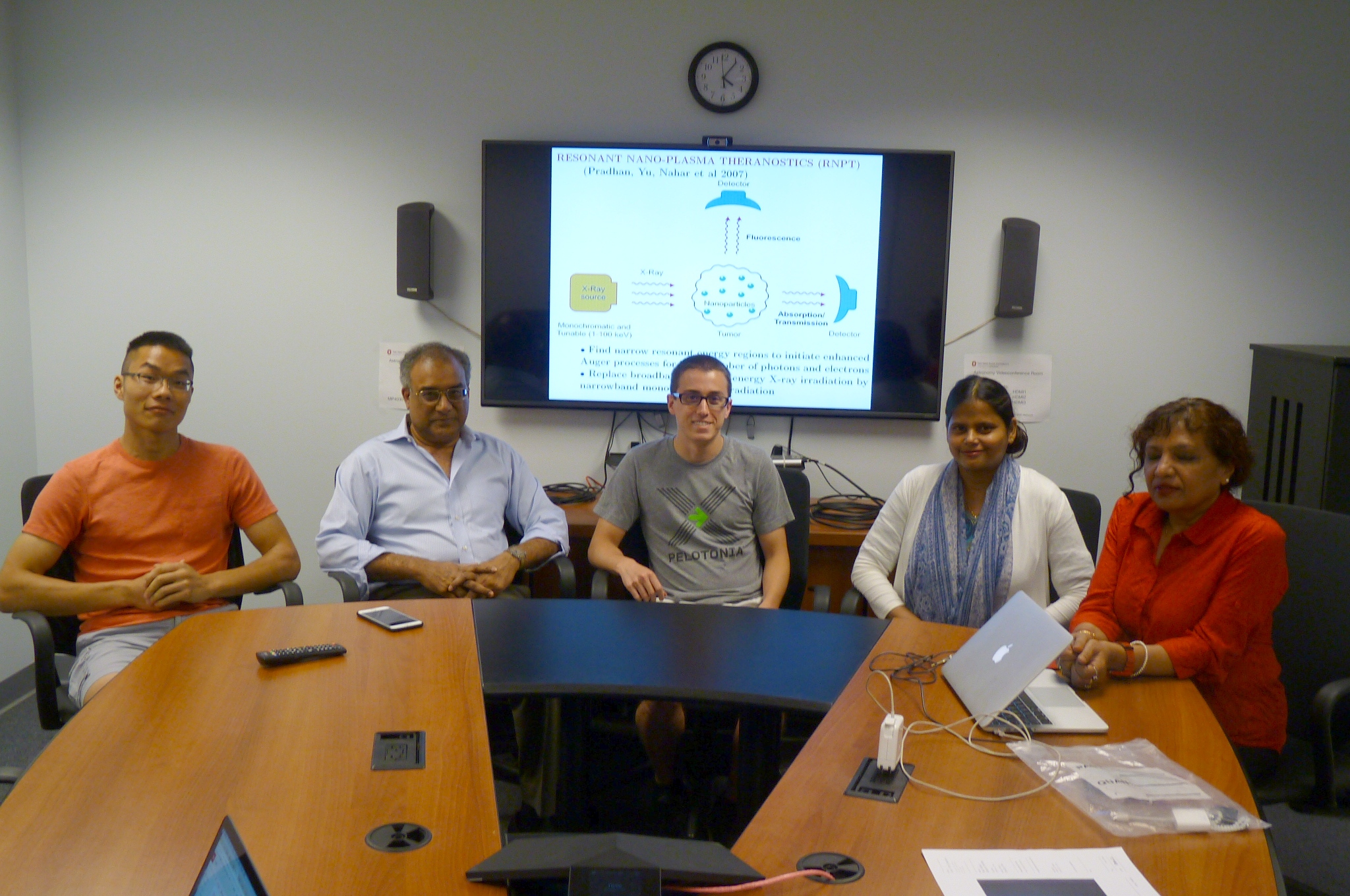
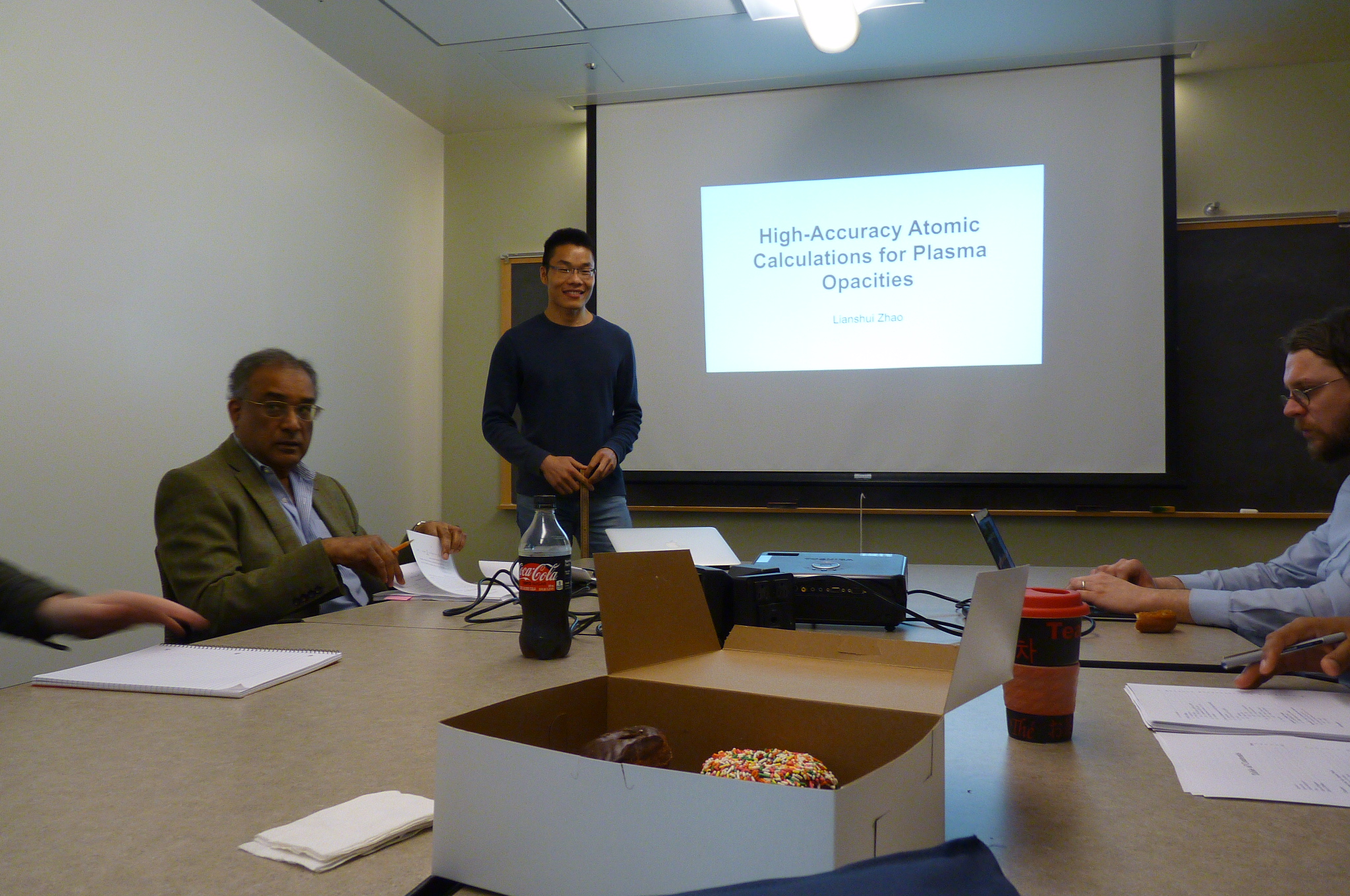
i) Claudio Mendoza visit, Dec 2017, ii) Congratulations as Max Westphal
received Paletonia Fellowship for 2018-2020 for RNPT work, iii) Lianshui
Zhao defends his Ph.D. thesis, May 1, 2019
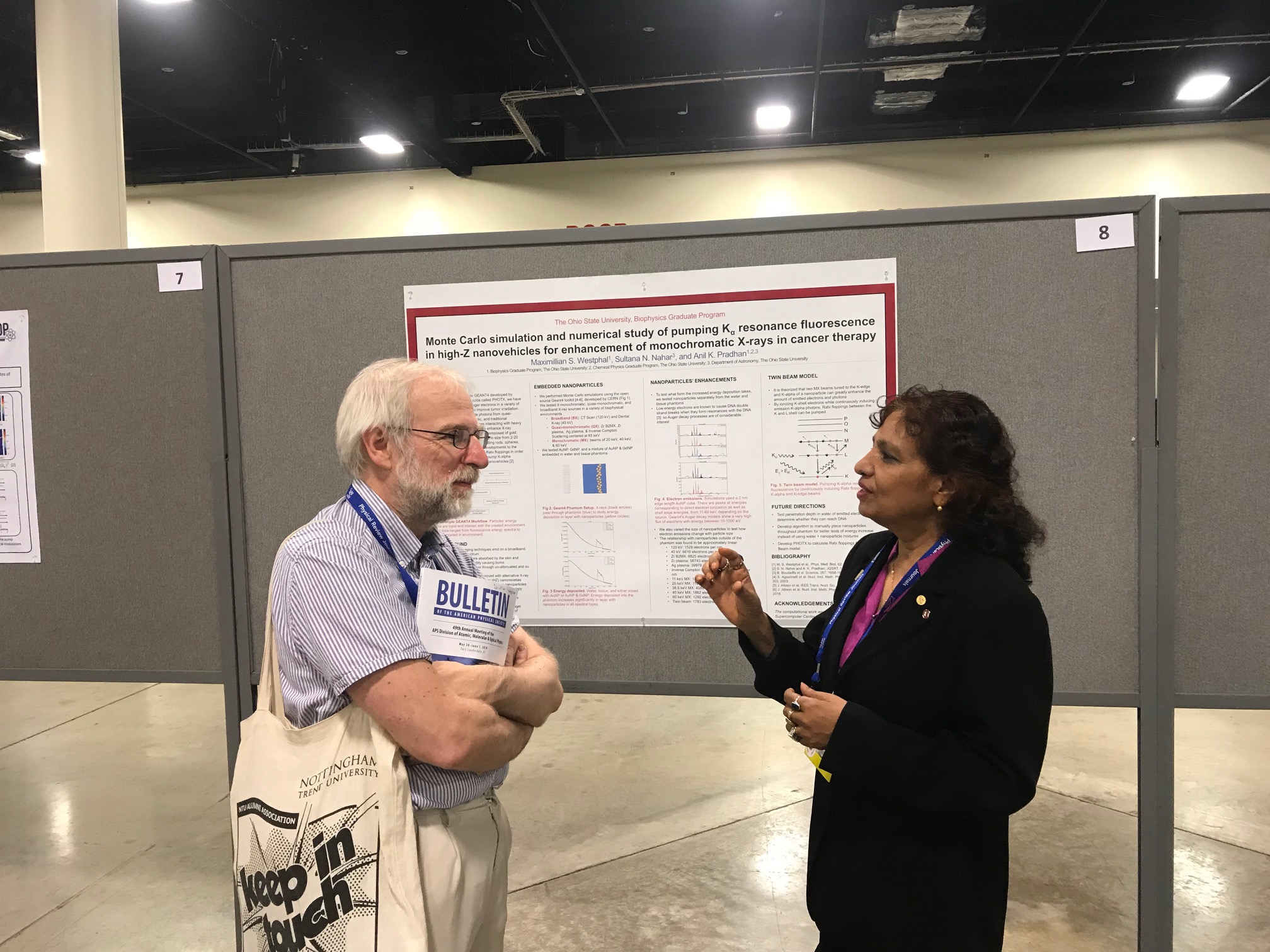
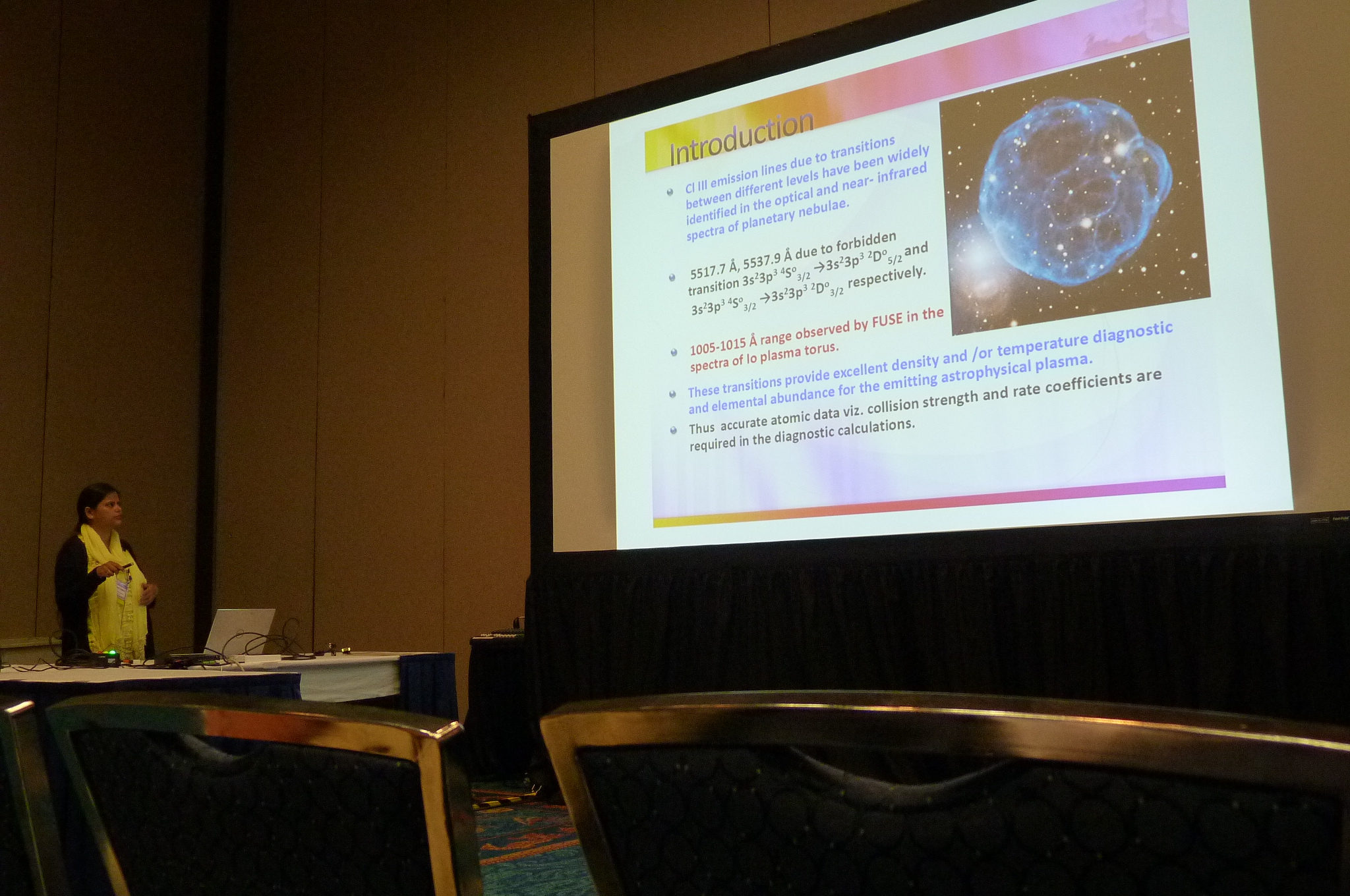
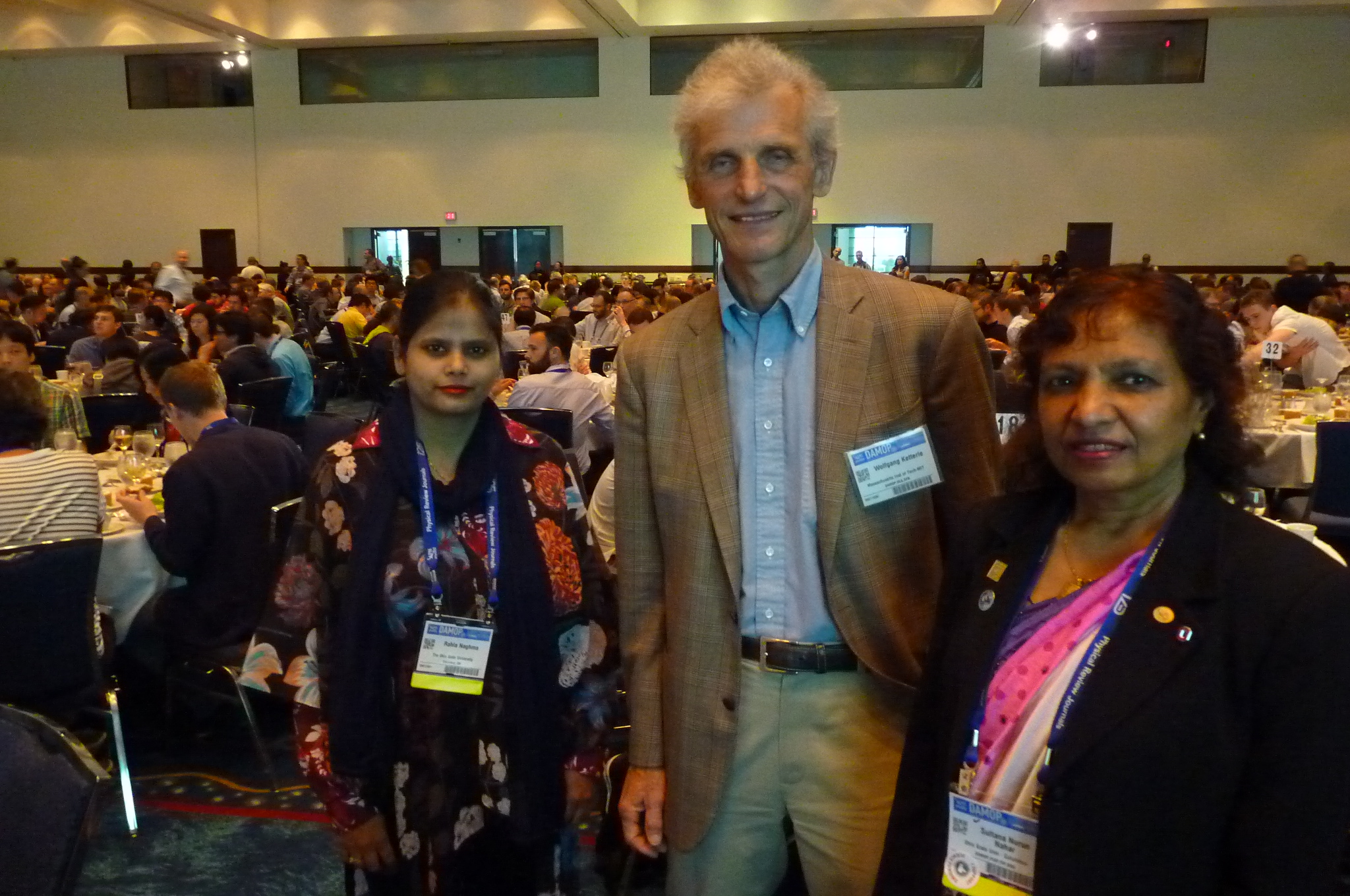
DAMOP conference at Lauderale, Fl 2018
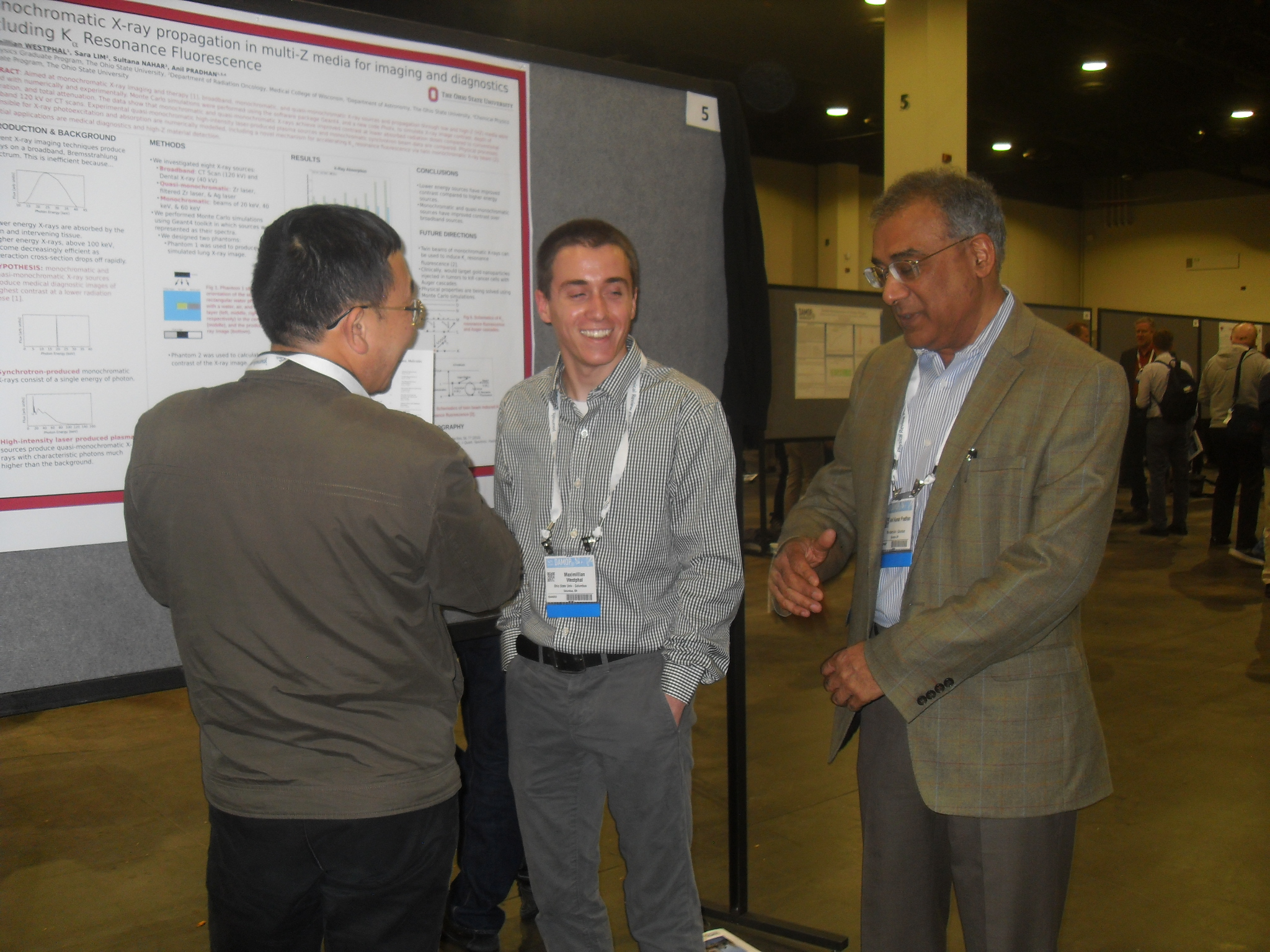
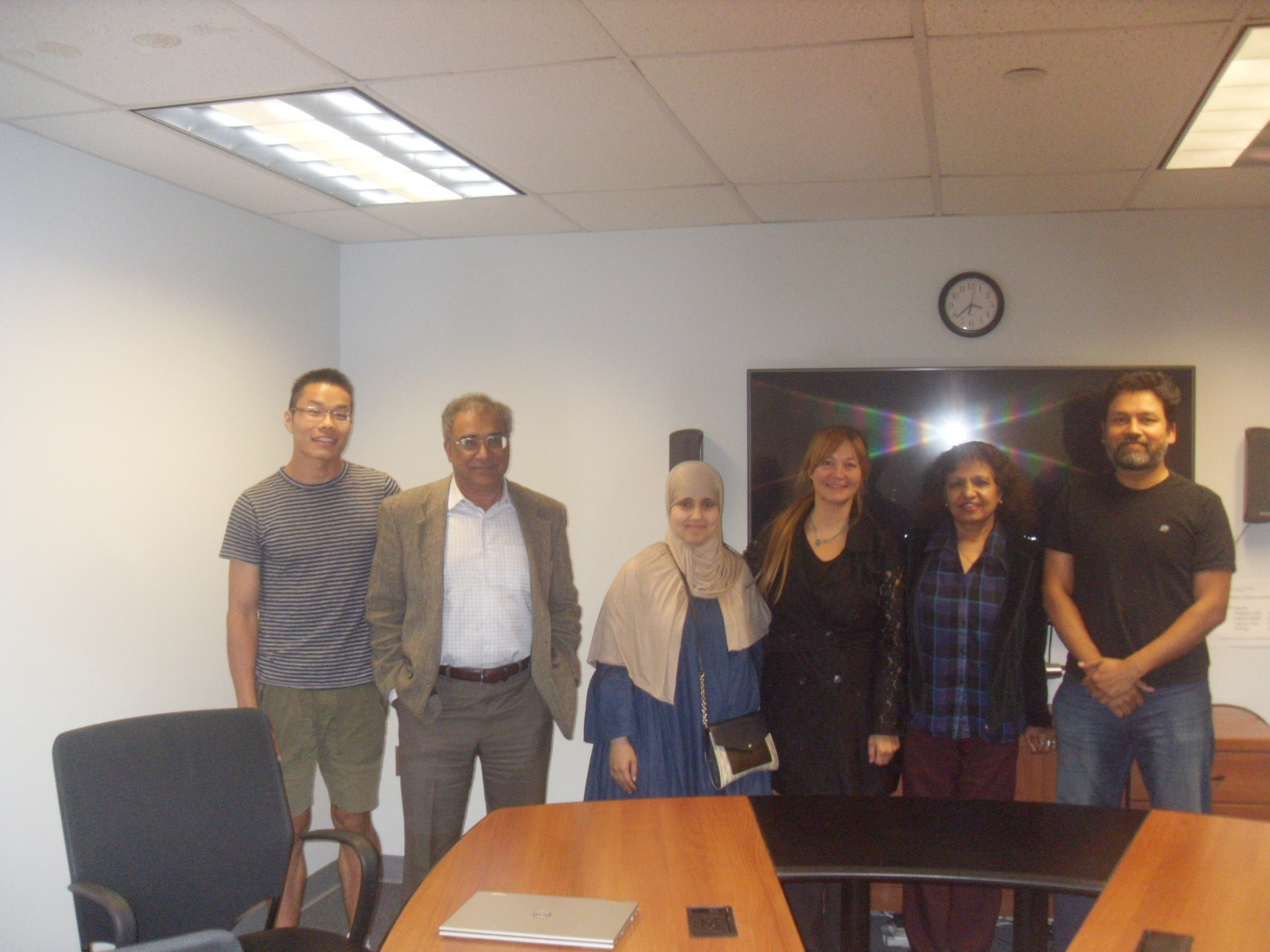
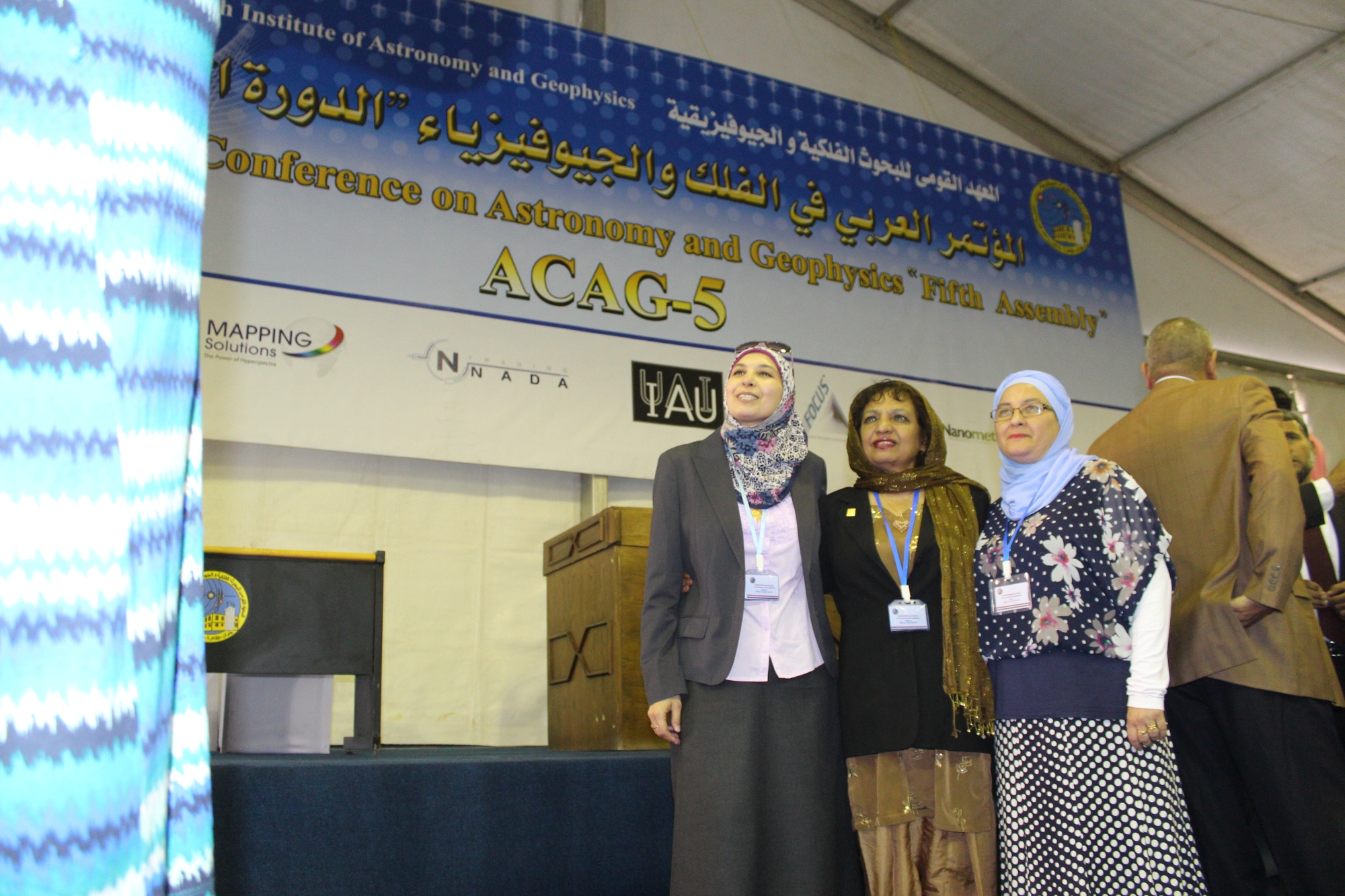
i) Max's presentation at DAMOP 2016, ii) Burcin
(Miami University, OH), Muneera (Dammam University) made presentations at
Astronomy group meeting, August 2016
iii) Sultana at the Arab Conference of
Astronomy and Geophysics, 5th assembly (ACAG-5), Egypt 2016,
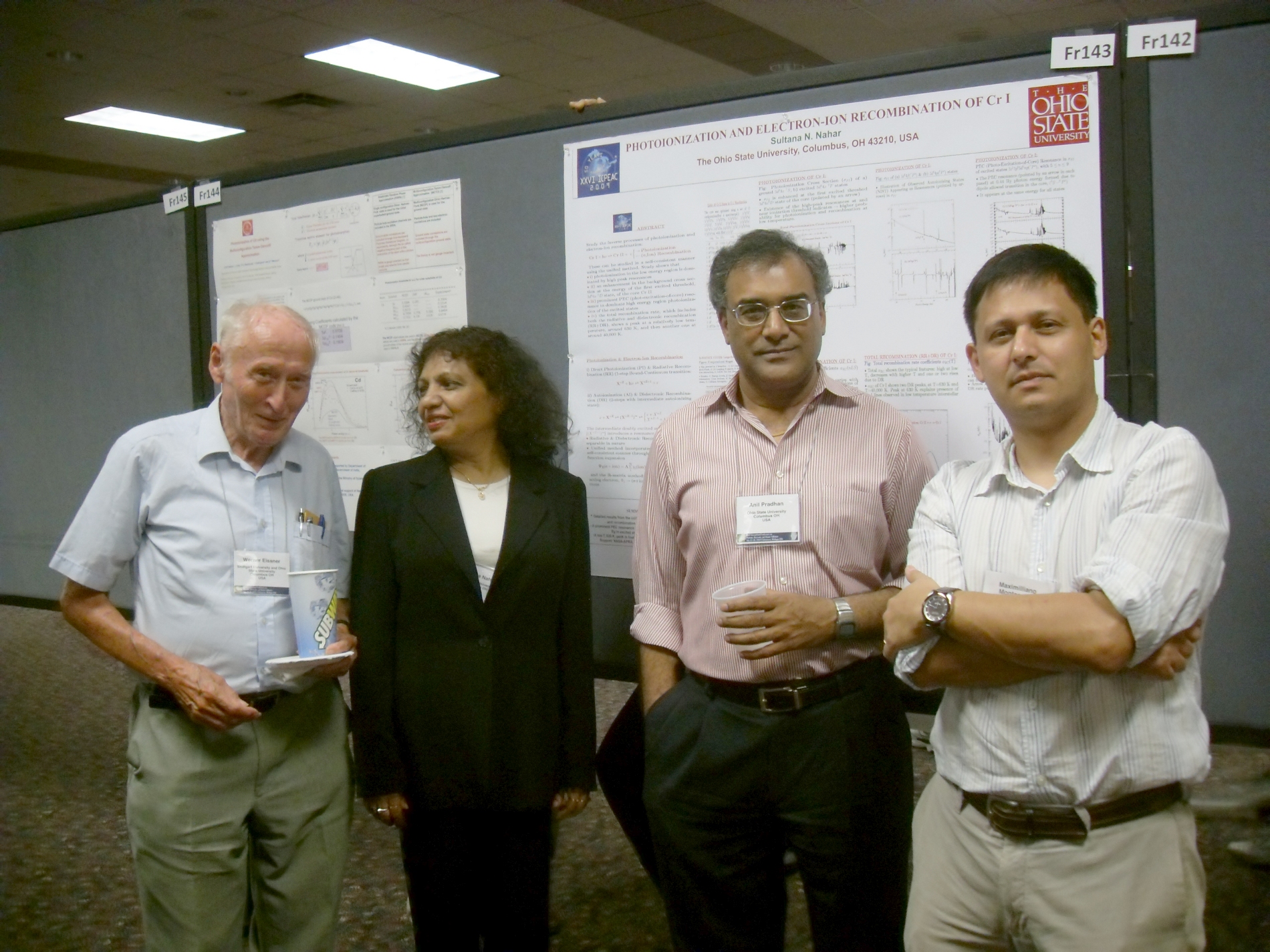
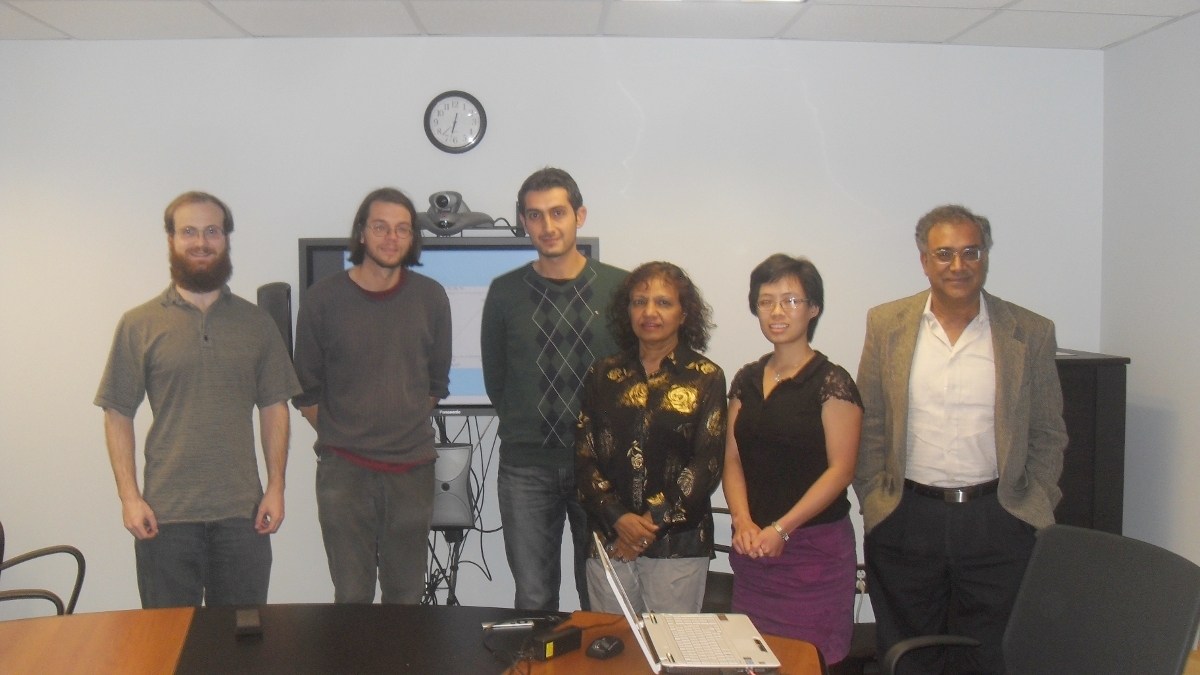
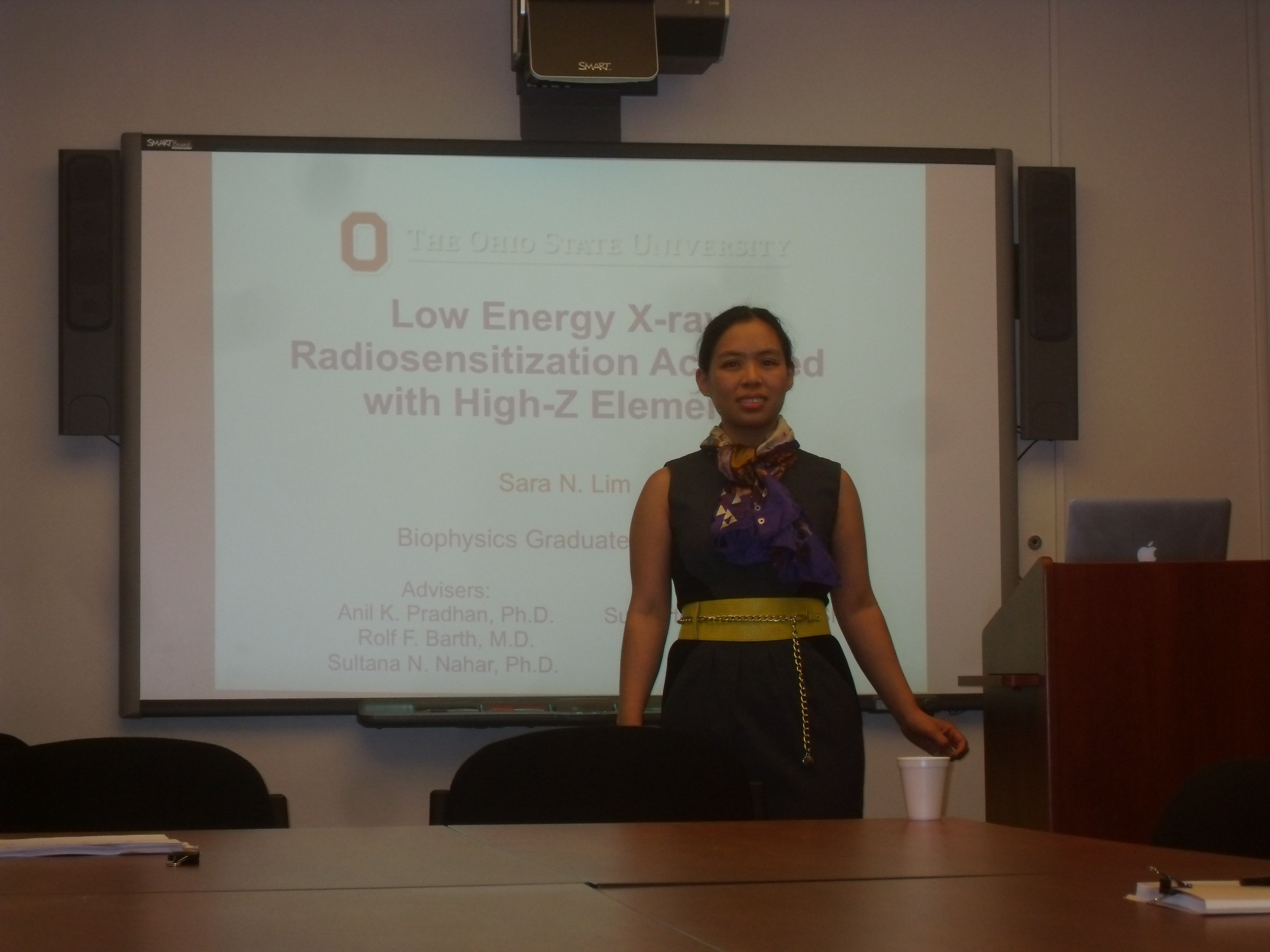
i) Group at ICPEAC conference 2009, ii) Group in 2013, iii) Sara's Ph.D.
defence in 2014, i) "Low Energy X-ray Radiosensitization
Activated with High-Z Elements",
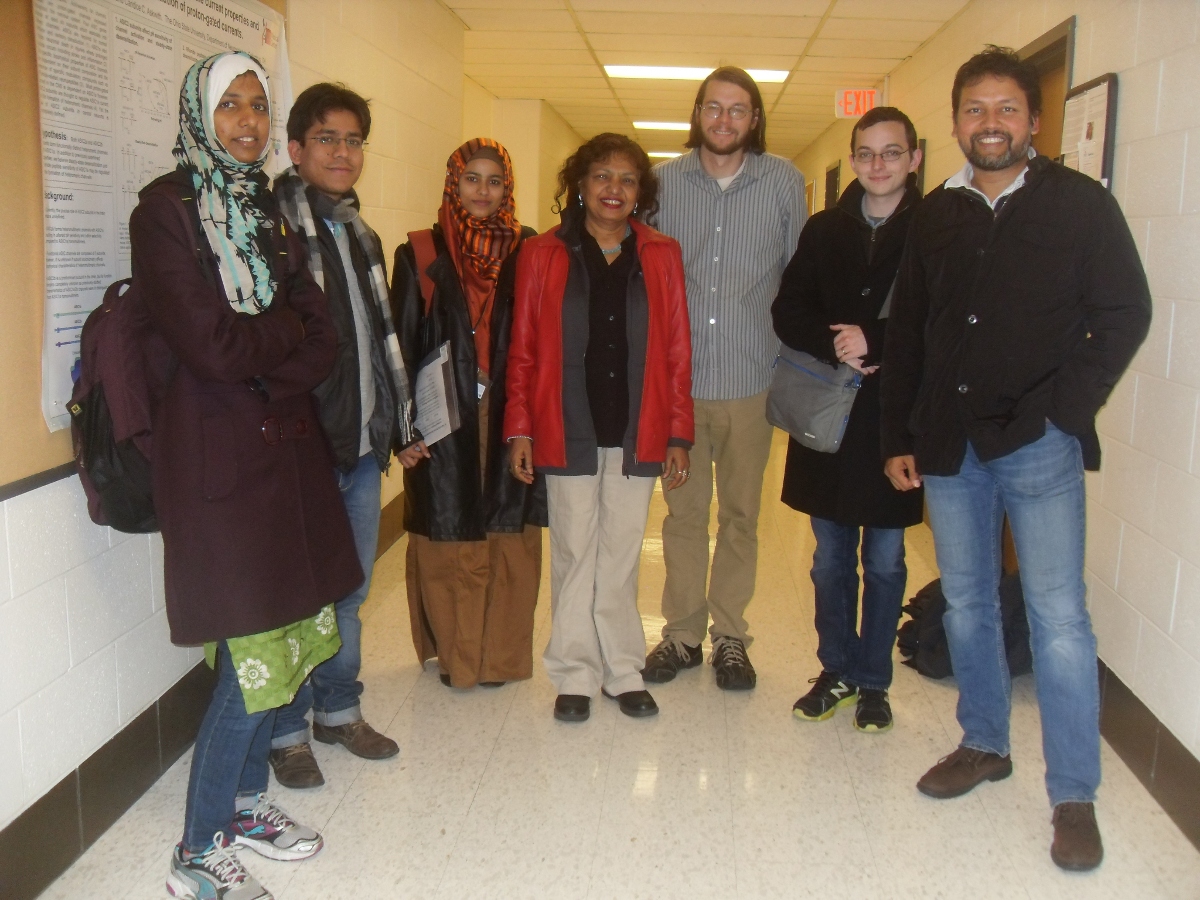
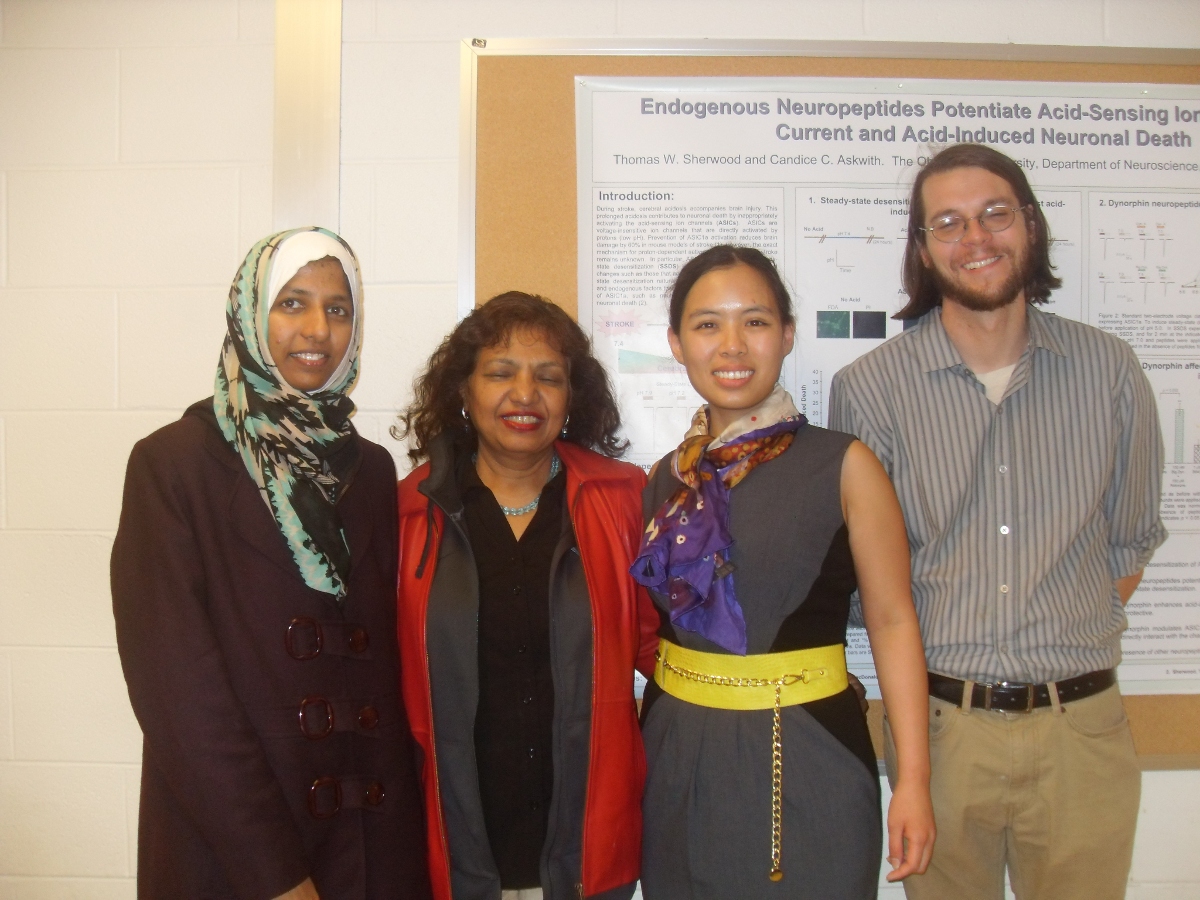
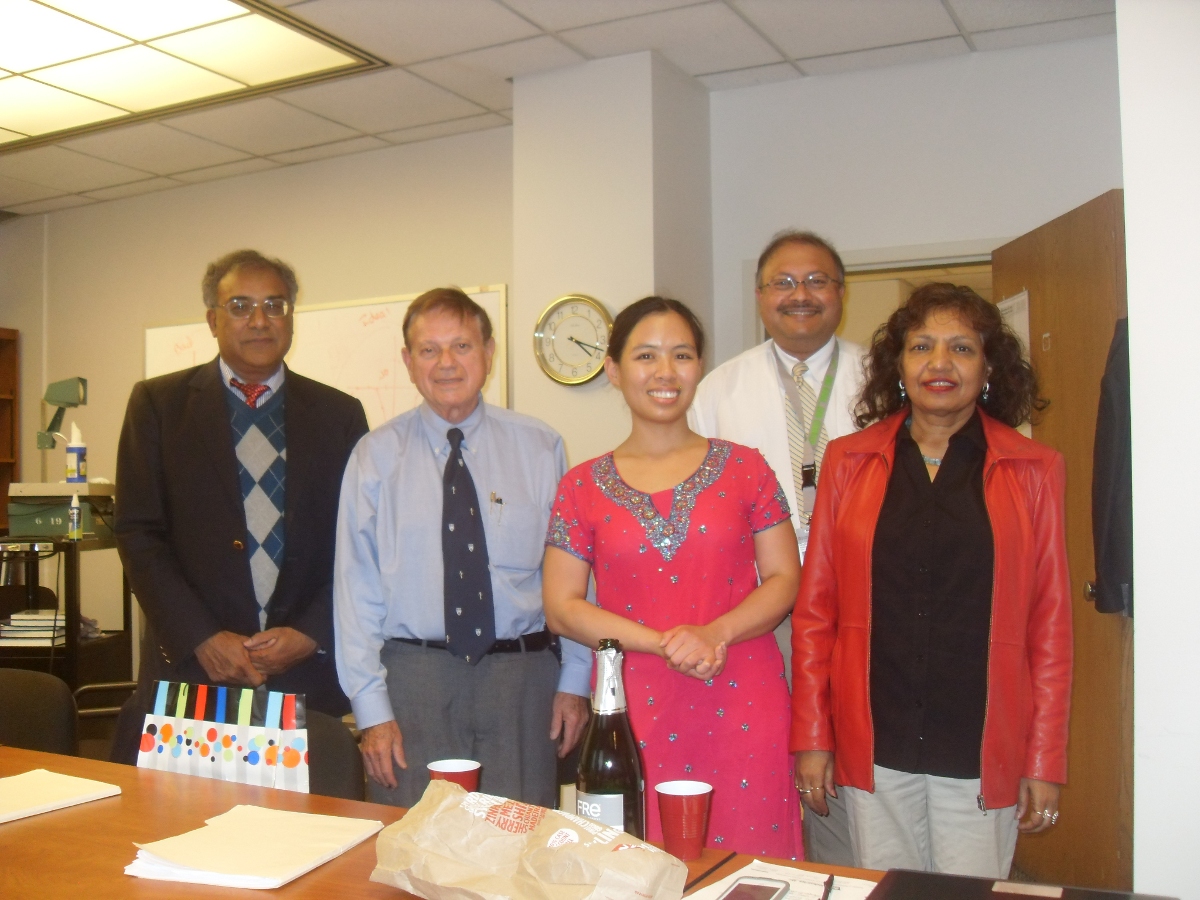
Sara's defence i) Group waiting in Graves Hall hallway, ii) Dr. Sara N. Lim,
iii) Sara with research advisors, OSU, November 6, 2014
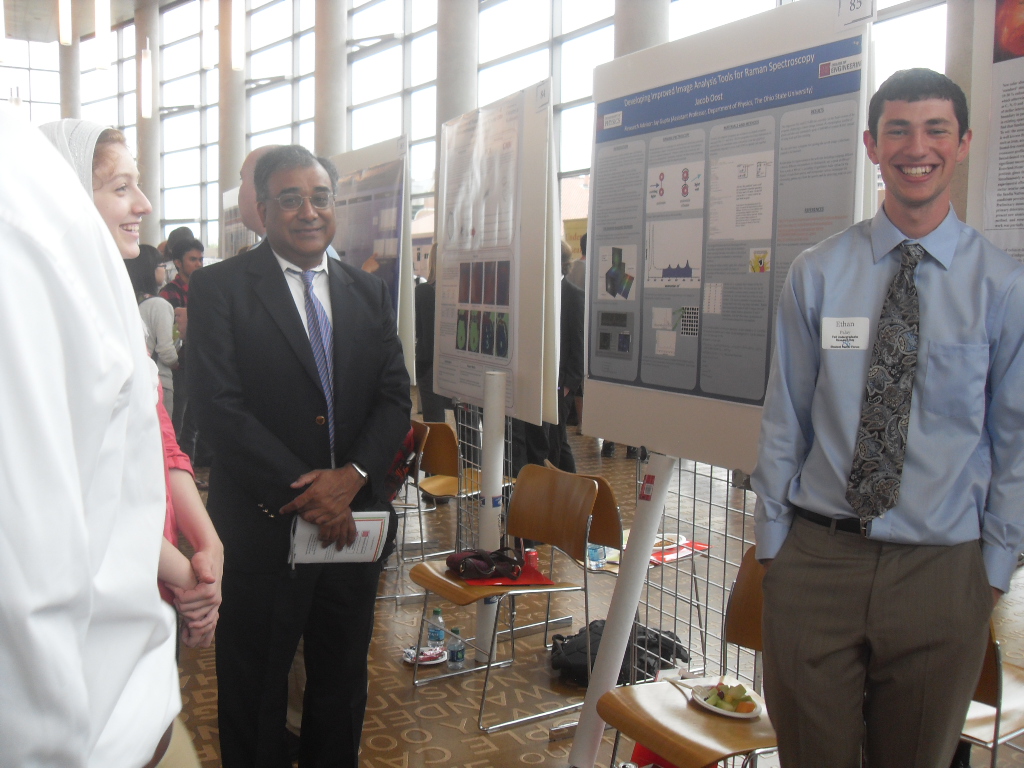
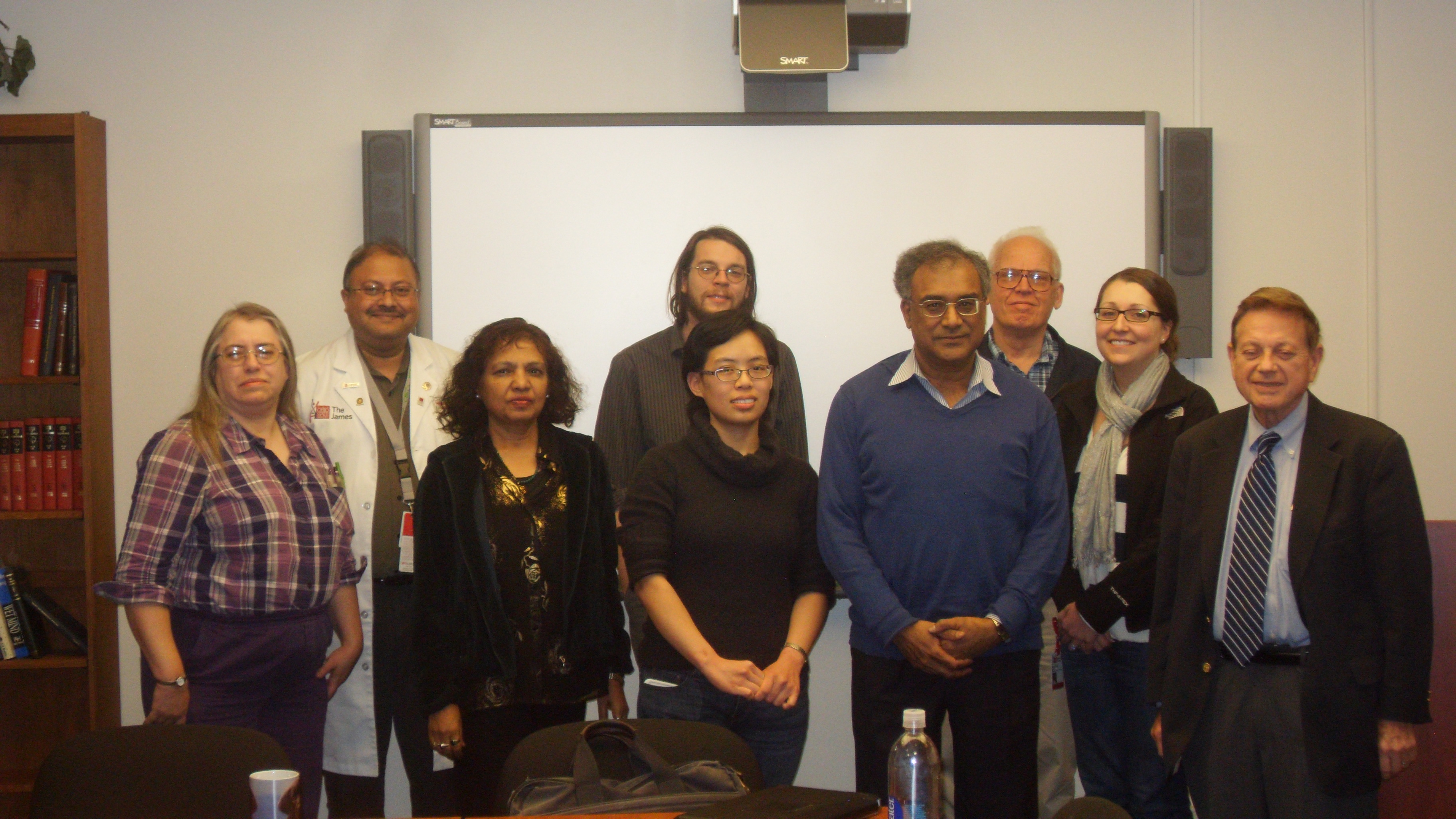
Ethan Palay presents collsional work
at the Undergraduate Scholar Presentation, OSU, 2012, ii) Research group RNPT
2012

2011: Group meeting- Sultana, Michael, Sara, Ethan, Anil
Intl Symp Molecular Spectroscopy, Ohio State University, 2008: Sultana
presented invited talk at the session honoring Russ Pitzer who
received honorary plaque at the meeting
picnic
Events at DAMOP07 where Sultana received
APS Fellowship recognition, Calgary, Canada, June, 2007
Highlights of Scientific research:
2025:
1. Astrobites News, Denison University, March 21, 2025:
"UR:
SPECTRA Analysis of Early Universe Galaxies Using JWST Data"
2024:
1. OSC press release featuring story titled "Ohio
State astronomy researcher unveils the sun¿s secrets with OSC support" on
the web, October 17, 2024. This will be included in the OSC Annual Report
for distribution.
2020:
1. OSC press release featuring story titled "Ohio
9.  OH-TECH press release of featured story in 2019-2020 Research report
"Breaking Barriers
Nahar aids female Muslim scientists with supercomputing", published in 2021
OH-TECH press release of featured story in 2019-2020 Research report
"Breaking Barriers
Nahar aids female Muslim scientists with supercomputing", published in 2021
- psoted as highlights of 2020
Research Report "Breaking Barriers"
- In the OSC Annual 2020 report: "Breaking Barriers
Nahar aids female Muslim scientists with supercomputing" (p.16 with different
picture)
2017:
1.  OH-TECH press release feature
"Educating the masses:
OSC helping Nahar share computational knowledge in Columbus, around the
world", August 24, 2017
OH-TECH press release feature
"Educating the masses:
OSC helping Nahar share computational knowledge in Columbus, around the
world", August 24, 2017
2.  OSC Annual Report
2016-2017 article "OSC HELPING NAHAR SHARE
COMPUTATIONAL KNOWLEDGE IN COLUMBUS, AROUND THE WORLD", p.8-10 (p.10-12
on webfile), OH-TECH
2017
OSC Annual Report
2016-2017 article "OSC HELPING NAHAR SHARE
COMPUTATIONAL KNOWLEDGE IN COLUMBUS, AROUND THE WORLD", p.8-10 (p.10-12
on webfile), OH-TECH
2017
2016:
1.  OH-TECH outreach featured blog on lecture course at Cairo University:
"Recent
workshop illustrates OSC’s support", December 2016
OH-TECH outreach featured blog on lecture course at Cairo University:
"Recent
workshop illustrates OSC’s support", December 2016
2014:
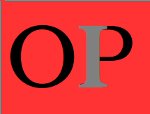 THE
OPACITY PROJECT &
THE
OPACITY PROJECT &
 THE
IRON PROJECT
THE
IRON PROJECT
 Prof.
Micheal J. Seaton (founder of the OP)
Prof.
Micheal J. Seaton (founder of the OP)
 THE
OPACITY PROJECT &
THE
OPACITY PROJECT &
 THE
IRON PROJECT
THE
IRON PROJECT
 Prof.
Micheal J. Seaton (founder of the OP)
Prof.
Micheal J. Seaton (founder of the OP)



















































![]() OH-TECH press release of featured story in 2019-2020 Research report
"Breaking Barriers
Nahar aids female Muslim scientists with supercomputing", published in 2021
OH-TECH press release of featured story in 2019-2020 Research report
"Breaking Barriers
Nahar aids female Muslim scientists with supercomputing", published in 2021
![]() OH-TECH press release feature
"Educating the masses:
OSC helping Nahar share computational knowledge in Columbus, around the
world", August 24, 2017
OH-TECH press release feature
"Educating the masses:
OSC helping Nahar share computational knowledge in Columbus, around the
world", August 24, 2017
![]() OSC Annual Report
2016-2017 article "OSC HELPING NAHAR SHARE
COMPUTATIONAL KNOWLEDGE IN COLUMBUS, AROUND THE WORLD", p.8-10 (p.10-12
on webfile), OH-TECH
2017
OSC Annual Report
2016-2017 article "OSC HELPING NAHAR SHARE
COMPUTATIONAL KNOWLEDGE IN COLUMBUS, AROUND THE WORLD", p.8-10 (p.10-12
on webfile), OH-TECH
2017
![]() OH-TECH outreach featured blog on lecture course at Cairo University:
"Recent
workshop illustrates OSC’s support", December 2016
OH-TECH outreach featured blog on lecture course at Cairo University:
"Recent
workshop illustrates OSC’s support", December 2016